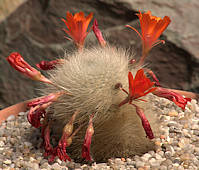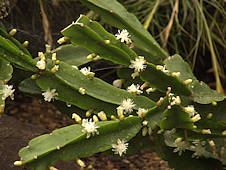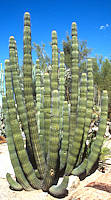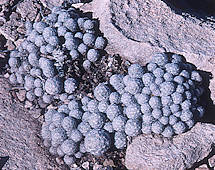
The large family Cactaceae is one of the most distinctive familes of dicotyledenous flowering succulent plants, with around 90 genera and 2500 species, ranging in size from less than half an inch to tens of feet in height. Cacti are exclusively native to the American continent including the West Indies with a solitary exception of the epiphytic Rhipsalis baccifera which is distributed in Africa, Madagascar and Ceylon as well as in South America, Mesoamerica and the Caribbean. Cacti generally have 22 chromosomes but African variants of Rhipsalis baccifera are tetraploid.
Morphology: Most species of Cactaceae are spiny stem succulents, although there are a few woody shrubs (Pereskia) and more or less succulent epiphytes. Some species have tuberous roots or a fleshy taproot. Many cacti have ribbed bodies that allows easy expansion in response to water uptake after brief showers of rain and contraction in times of extended drought. Water loss is reduced by a waxy epidermis.
All Cactaceae have distinctive modified buds that have evolved into specialised areoles from which grow multiple spines and glochids (right). These should be distinguished from solitary spines or thorns on other plants e.g. spiny Euphorbias, that sometimes branch above the plant body. In some cactus species, spination is minimal, or occurs only during some phases of the succulent plant's life or vestigal spines are present as hairs. Leaves where present are alternate, but usually reduced or absent. Fruits are generally berries with multiple seeds, which may be surrounded by juicy flesh or by a more or less dry membrane and may have external areoles with spines or glochids.
Biochemistry: CAM metabolism allows carbon-dioxide to be taken up during cool nights and stored as malic acid for use in photosynthesis during hot, sunny days, greatly reducing water loss during transpiration. Betalain pigments are present and characteristic of the family Cactaceae and of the Order Caryophyllales in which they are included, as is absence of anthocyanin pigments found in many other families of flowering plants. Betalains and anthocyanins never occur in the same plant. Betalains are responsible for the red or violet colouration of some cacti when stressed. Ferulic acid in the cell walls of Cactaceae is also a common characteristic.

Uses: Several species of cacti are cultivated for their juicy fruit (e.g. Opuntia ficus-indica, Selenicereus sp., Hylocereus sp.) or fruit is collected from wild plants. Through introduction, Cactaceae and especially Opuntia are found throughout the tropics. In some places cacti have become invasive weeds.
Many species of cacti are cultivated as ornamental house plants or for dry landscaping and they are grown from seed in vast numbers. Some species e.g. Echinocactus grusonii are far more common in cultivation than in their habitat, much of which was destroyed by construction of a reservoir. All species of cacti are protected as CITES 1 or CITES 2 plants, which presents a barrier to free trade even for nursery grown cacti and artificial hybrids with no natural distribution.
Cactus taxonomy appears to follow a record of their assumed evolutionary history. Various authors have estimated that the Cactaceae evolved as recently as in the last 10,000 years or as long ago as 20 - 30 million years. However, as cacti are not well-represented in the fossil record, the logical taxonomic sequence is based mainly on morphology. Recent DNA studies support the general groupings, but suggest some taxonomic rearrangements of species. This family contains numerous genera which seem to be constantly under revision.
|



Above: examples of
cactus spine clusters

|
- Subfamily Pereskioideae: broad leaves, no glochids.
Maihuenia, Pereskia
(or Maihuenia may be separated into Subfamily Maihuenioideae.)
- Subfamily Opuntioideae: fleshy round leaves present or absent, glochids present.
Austrocylindropuntia, Brasiliopuntia, Consolea, Corynopuntia, Cylindropuntia, Cumulopuntia, Grusonia, Maihueniopsis, Micropuntia, Opuntia, Pereskiopsis, Pterocactus, Quiabentia, Tacinga, Tephrocactus, Tunilla.
- Subfamily Cactoideae: no leaves*, no glochids. (incomplete list of genera)
Ariocarpus, Arrojadoa, Astrophytum, Aztekium, Blossfeldia, Calymmanthium, Carnegiea, Cereus, Cleistocactus, Copiapoa, Coryphantha, Dendrocereus, Echinocactus, Echinocereus, Echinomastus, Echinopsis, Epi hybrids, Epiphyllum, Epithelantha, Escobaria, Espostoa, Ferocactus, Geohintonia, Gymnocalycium, Hylocereus, Lepismium, Leuchtenbergia, Lobivia, Lophocereus, Lophophora, Maihueniopsis Mammillaria, Matucana, Melocactus, Neolloydia, Obregonia, Oreocereus, Pachycereus, Parodia, Pelecyphora, Pilosocereus, Pediocactus, Peniocereus, Rebutia, Rhipsalis, Sclerocactus, Schlumbergera, Selenicereus, Stenocactus, Stenocereus, Strombocactus, Thelocactus, Toumeya, Trichocereus, Turbinocarpus, Uebelmannia, Weingartia, Wilcoxia, Zygocactus and all other genera.
*Except that some species have seed leaves.
|
 Subfamily Pereskioideae (leafy cacti) Subfamily Pereskioideae (leafy cacti)
The 20 species of succulent plants in this subfamily are shrubs and trees with persistent flat leaves, areoles with spine clusters and no glochids. Pereskioideae are thought to be low down in the evolutionary tree of the Cactaceae. The two mat-forming species with persistent rounded succulent leaves in the genus Maihuenia are sometimes separated into Subfamily Maihuenioideae.
All species in Subfamily Pereskioideae are native to central and South America.
See: The Leafy Cactus Page
|
 Subfamily Opuntioideae (prickly pears) Subfamily Opuntioideae (prickly pears)
This sub-family includes over 300 species of cacti with the common characteristic of irritating barbed hairs (glochids) as well as ordinary spines. The seeds are hardened with a stone-like aril. Leaves where present are vestigial and short lived. Members of this subfamily range in size from mat-forming plants to shrubs and trees.
Opuntiads are native to a very wide range from central Canada to Patagonia in South America and naturalised in many warm climates where they may be regarded as invasive.
See: The Opuntiad Page
|
 Subfamily: Cactoideae Subfamily: Cactoideae
This is the largest and most diverse subfamily within the Cactaceae, including over a thousand species and the focus of this page. This group of succulents covers a wide range of forms and lifestyles, ranging in size from less than half an inch to trees over 60ft tall. Most but not all cacti have spines but glochids are never present and leaves are absent or vestigial e.g. cotyledons. Instead of leaves, stems are photosynthetic. Most flower colours are seen with the exception of blue. Flowers are followed by berries which may be fleshy or dry and contain multiple small seeds.
All species of cacti are native to the Americas with the exception of a single species (Rhipsalis baccifera) which is also found in India, Ceylon and Africa.
|

Ariocarpus Scheidweiler 1838 (Living Rocks)
Name: Greek aria = an oak type and carpos = fruit
The genus Ariocarpus includes 8 species of cacti whose spines have mostly degenerated into tufts of wool. These plants grow flush with the ground and have thick tap roots which require very well-drained conditions. The plant consists of a rosette of spineless, triangular tubercles and in mature plants a wooly apex. The succulent tubercles are protected from herbivores by their content of bitter alkaloids e.g. Hordenine.
Native to limestone mountains of South Texas into central Mexico. The single species in Texas (A. fissuratus) is not uncommon within its range, but well camouflaged among rocks. However, the shocking pink flowers produced in the Autumn betray the positions and numbers of plants. In cultivation Ariocarpus are very slow growing and require careful watering or the tap root will rot. Some people like to add ground limestone to their potting mixture, which must be very free-draining. Grafting is commonly used to increase the growth rate, but produces bloated plants.
|
 |
 |
Ariocarpus fissuratus (Engelmann) K. K. Schumann 1894 (Living Rock Cactus)
Native to Northern Mexico and Texas.
Photo: Big Bend National Park, Texas.
|
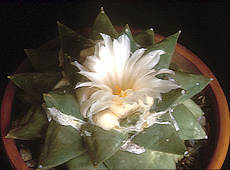 |
Ariocarpus retusus Scheidweiler 1838
Name: Latin retusus = blunt tip
This somewhat variable plant is the type species for the genus. The rosette of spineless tubercles is supported by a subterranean tuberous body which requires excellent drainage.
Native to the high Chihuahuan desert in the Mexican states of Coahuila, Nuevo León, San Luis Potosi, Tamaulipas, and Zacatecas, growing on limestone and gypsum.
|
 |
Ariocarpus scaphirostris F. Boedeker 1930
Syn. Ariocarpus scapharostrus Boedecker 1930
Name: Latin scaphe = peak + rostrum = face
The tubercles of the mature plant are spineless, but seedlings have spines.
Native to the Mexican state of state of Nuevo León.
|
|
Arrojadoa Britton & Rose 1922
Named for: Miguel Arrojado Lisboa (1872 - 1932) Brazilian engineer and cactus collector
The genus Arrojadoa includes 6 species of columnar cacti with 10 to 15 ribs covered with bristly spines. Most species have quite slender stems, but one species has stems up to 3 in diameter. The waxy tubular flowers are bright pink and followed by pink to red berries.
Native to the dry tropical region of Northern Brazil and require constant warmth.
|
 |
Arrojadoa bahiensis (P.J. Braun & Esteves ) N.P. Taylor & Eggli 1994
Named for: the Bahia state of Brazil
This species has the thickest body in the genus and grows up to 3ft tall. The spherical to cylindrical stems have 9 - 14 ribs. The areoles, closely spaced along the apex of the ribs, produce cream-coloured wool and long brownish needle-shaped spines. Pink tubular flowers with white inner petals are produced near to the growing point followed by pink berries.
Native to central Bahia, Brazil where it is considered endangered.
|
 Astrophytum Lemaire 1839 Astrophytum Lemaire 1839
Name: Greek astron = star + phyton = plant
Astrophytum is a small genus of six species of North American cacti, within which is a remarkable diversity of form. The cactus bodies are globular to short columns with or without spines. The body plan of Astrophytum is star-shaped with 5 - 8 ribs, which may be deeply incised or minimally delineated by a line of areoles. The recently-discovered, distinctive A. caput-medusae has sprawling stems arising from a caudex and is sometimes regarded as a member of the monotypic genus Digitostigma. The surface of all species generally has white patches of flocking but this may be absent or washed away by rain.
Astrophytum are native to Southern Texas and Mexico.
The variable symmetry of form and white markings of these plants has appealed to collectors, especially in Japan where many extreme examples have been bred.
|
 |
Astrophytum myriostigma Lemaire 1839 (Turk's Head Cactus)
Name: Greek myrios = innumerable + stigma = stain (many-dotted)
The three to seven, usually five-ribbed solitary plant body is covered with thousands of tiny dots of white trichomes to a variable extent. There are no spines. Yellowish, sweetly-scented flowers with many petals are produced at the apex of the plant and are followed by a large (1 inch) red fruit.
Native to the Mexican states of Coahuila, Durango, Nuevo León, San Luis Potosí and Tamaulipas. The plant should be watered from below to preserve the white flocking. Some all-green horticultural selections have no trichomes.
Photo: Benno Stander 2014, of a cultivated plant in South Africa.
|
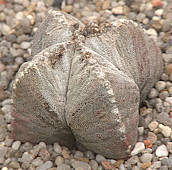 |
Astrophytum myriostigma quadricostatum M. Mittler 1841
A nursery-selected form with four ribs instead of the more usual five ribs. Such plants also occur in the wild population.
Flowers are pale yellow. Further selections have led to all-green plants without white trichomes and several named cultivars with distinctive patterns of white trichomes.
|
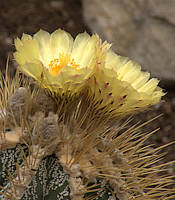 |
 |
Astrophytum ornatum (De Candolle) Weber ex Britton & Rose 1922 (Bishop's Cap)
Name: Latin ornatus = decorated, referring to the woolly flakes on the body
This is the largest species of Astrophytum. The five to ten, usually eight-ribbed solitary plant body has bands of white flocking, to a very variable extent, in some variants becoming near confluent. Yellowish flowers with many petals are produced at the apex of the plant.
Native to canyons and limestone cliffs in the Mexican states of Hidalgo, Queretaro and Guanajuato.
|
 Blossfeldia Werdermann 1937 Blossfeldia Werdermann 1937
Named for: Harry Blossfeld (1913 - 1986) German botanist living in Brazil.
Blossfeldia is a genus of cacti with very small button-like bodies without ribs, tubercles or spines.
Blossfeldia is probably monotypic for Blossfeldia liliputana. Several species have been described, but probably better regarded as varieties.
Native to the Eastern side of the Andes mountains of Bolivia and Argentina at elevations of 4,000 to 12,000 ft.
Blossfeldia is sometimes included in Parodia as Parodia liliputana (Werdermann) N.P. Taylor 1987.
|
 |
Blossfeldia liliputana Werdermann 1937
Named for: fictional country of Lilliput inhabited by a race of tiny people (Gulliver's Travels, 1726, Jonathan Swift)
The tiny plant body less than half an inch in diameter has no rib, tubercles or spines but is dotted with areoles bearing white hairs. Unlike most other cacti,
Blossfeldia liliputana has no thickened outer cuticle but instead appears to be poikilohydric (can withstand dessication). The small flowers are white or pale yellow with bright yellow stamens.
Native to a range from Southern Bolivia to North-Western Argentina, growing in rock crevices on cliffs. Grafting accelerates growth but produces unnatural bloated golf ball sized plants.
|
 Calymmanthium F. Ritter 1962 Calymmanthium F. Ritter 1962
Syn. Diploperianthium F.Ritter 1958 (nom. nud.)
Name: Greek kalymma = veiled + anthos = flower, referring to tissue around the flower bud.
A monotypic genus for the primitive tree-like cactus Calymmanthium substerile from Northern Peru. Molecular studies suggest that Calymmanthium is basal to the lineage of the Subfamily Cactoideae.
|

RBG Kew |
 |
Calymmanthium substerile F. Ritter 1962
Syn. Calymmanthium fertile F. Ritter 1966 (designat. typi omissa.)
Name: substerile because the original discovery was of a non-flowering clone.
This cactus grows as a large shrubby tree, 25ft or more tall, with multiple stems from the base. The stem is segmented according to periods of growth, with three or four notched wing-like ribs furnished with areoles bearing long white to buff spines. This is a night flowering cactus. The large white to pink flowers are produced at the end of a stem-like segment which acts as a floral tube and within which they remain partly sheathed.
Native to mountains of Peru. Not commonly in cultivation in greenhouses because of its size, but can be seen in some tropical and sub-tropical botanic gardens.
|
 Carnegiea Britton & Rose 1908 Carnegiea Britton & Rose 1908
Named for: Andrew Carnegie (1835 1919) Scottish industrialist and philanthropist, spending most of his life in the USA.
This monotypic genus includes a large, tree-like cactus native to the Sonoran deserts of Arizona, Eastern California and the Mexican state of Sonora. The mis-spelled genus name Carnegia is occasionally seen, but really designates a genus of tropical moths.
|

By US Route 60
Phoenix-Wickenburg, Az. |
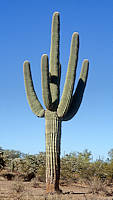
By US Route 86, South of Why, Az. |

Desert Botanic Garden Phoenix, Az. |

By US Route 86, South of Why, Az. |
Carnegiea gigantea (Engelmann) Britton & Rose 1908 (Saguaro)
Syn. Cereus giganteus Engelmann 1848, Pilocereus giganteus (Engelmann) Rümpler 1885
Name: Saguaro is Mexican-Spanish from a native name.
The Saguaro cactus has a tall, ribbed columnar stem up to 30ft tall, often branching with age. A Saguaro may live for more than 200 years, growing very slowly at first in the shelter of a 'nurse bush' and then a little faster once it has reached several feet in height. The branches tend to curve upwards unless affected by cold in which case they develop a permanent droop. The trunk is covered by a waxy skin, becoming corky low down and there are 2 inch spines along the ribs. The ribbed trunk allows the stem to expand and contract without splitting, depending on the availability of water. There is a short tap root but most of the roots form a shallow network to a radial distance similar to the height of the cactus, providing a large area from which to scavenge moisture. In the Spring, white trumpet-shaped flowers with yellow stamens are produced around the apex of the stem, followed by juicy red fruit. The Saguaro is the state flower of Arizona.
Native to the Sonoran deserts of Arizona, Eastern California and the Mexican state of Sonora. The Tohono O'odham Indians valued Saguaro fruit which can be used to make preserves or fermented into wine. The internal wooden ribs of the cactus were used for construction and the spines as sewing needles. The Saguaro cactus is a common emblem on artistic and advertising material to imply a connection with the South-West USA. Several Western films feature Saguaros well outside their natural range.
Saguaros seem a little more prone to abnormal growths than other cacti. Plants with a cristate growing point are not uncommon, although a tiny proportion of all Saguaros. The cause is unknown but may reflect damage by frost or other agents.
|
 Cereus Miller 1754 Cereus Miller 1754
Name: Latin cereus = waxy, torch
Cereus was the first genus of cacti to be described in 1754, but the name is at least a hundred years older. For a long time most columnar cacti were placed in the genus Cereus but since the 1920s many species have been reclassified under other names.
Cereus currently includes 33 species of tall columnar cacti with shrubby or tree-like growth habit, native to South America. Stems are usually angled or ribbed with spines but no cephalium, except that Cereus mortensenii develops a pseudocephalium. Flowers are funnel-shaped and white, pink or purple and followed by spherical to oval fleshy red or yellow fruit with large ovoid glossy black seeds.
|
 |
Cereus hankeanus F.A.C. Weber 1897
Syn. Cereus forbesii spiralis Otto (Spiraled Cereus)
This shrubby cactus produces a candelabra of ascending glaucous-green 4 - 8 angled stems up to 5 in diameter and 15ft tall. Stems may grow with stright ribs or adopt a spiral mode of growth in either direction. The margins of each rib bears well-spaced clusters of 2 - 5 radial light-brown spines with 1 - 3 stouter central spines. White flowers are followed by large purple fruits.
Cereus hankeanus is native to Argentina, Bolivia, and Paraguay. The spiraled arm form is seen in Brazil.
|
 |
Cereus stenogonus K.Schumann 1899
This tree-like cactus has branching stems that eventually form a huge candelabra up to 30ft tall. Flowers are greenish-white on the end of a long flower tube.
Native to low elevations in Argentina, Paraguay and Uruguay
|
 Cleistocactus Lemaire 1861 Cleistocactus Lemaire 1861
Name: Greek kleistos = closed, referring to flowers that seldom open
The genus Cleistocactus includes 50 or more species of South American columnar cacti whose tall, narrow ribbed stems have closely spaced areoles with many flexible spines giving some species a furry appearance. Stems usually branch at their base making large shrubby clumps. Their red or orange tubular flowers have exserted style and stamens but often hardly open otherwise. They tend to be produced on the sunny side of the stem.
Native to the mountains of Argentina, Bolivia, Peru, and Uruguay, growing at elevations of up to 9800 ft.
Several other genera have been lumped into Cleistocactus, making the genus more diverse. Plants that used to be in the genus Borzicactus have flowers that open a little wider than those of the original Cleistocactus group.
|
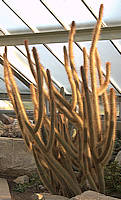 |
 |
Cleistocactus candelilla Cárdenas 1952
Name: Spanish candelilla = small candle
Tubular pink-red flowers form mostly on the sunny side of the stem and are followed by pink fruits.
Native to the Bolivian regions of Cochabamba, Potosí and Santa Cruz and especially Amboró National Park.
|
 |
 |
Cleistocactus hyalacanthus (K.M. Schumann) Roland-Gosselin 1904
Native to Argentina and Bolivia.
|

 |
Cleistocactus semaipatanus (Cárdenas) D.R. Hunt 1987
Syn. Bolivicereus samaipatanus Cárdenas 1951
Syn. Borzicactus samaipatanus (Cárdenas) Kimnach 1960
Name: grows near Samaipata in Bolivia
The long green stems with 14 - 17 ribs can grow upright as a shrubby plant for a while but tend to become prostrate, forming a tangled mat. The closely-spaced areoles produce 13 - 40 golden spines. Attractive tubular pink to red flowers with purple stamens are produced in early Summer. These flowers open wide which is why this cactus was originally classified as a Borzicactus. The small fruits are red with white or brown wool.
Native to the Andean Valleys in the Department of Santa Cruz, Bolivia but common worldwide as it is used for dry landscaping in warm climates. Needs a cool Winter to flower freely.
|
| |
Cleistocactus sepium (Kunth) A.Weber 1904
See: Matucana weberbaueri
|
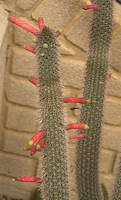 |
Cleistocactus smaragdiflorus (F.A.C.Weber) Britton & Rose 1920 (Emerald Flowering Cleistocactus)
Name: Latin smaragdinus = emerald green + florus = flower
Syn. Cleistocactus rojoi Cárdenas 1956
Named for : Leandro Rojo one of Cárdenas' field trip companions.
The tubular red flowers with a greenish tip open minimally but the style is exserted. The green colour seems to fade as the flower opens.
Native to Bolivia, Paraguay and Argentina.
|
 |
 |
Cleistocactus strausii (Heese) Backeberg 1934 (Silver Torch Cactus)
Syn. Pilocereus straussii
Named for: L. Straus (1862 - 1934) German merchant & cactus lover from Bruchsal, co-founder Deutsche Kakteen-Gesellschaft DKG
Native to high mountain ranges of Southern Bolivia and Northern Argentina, growing above 9800 ft.
|
 |
 |
Cleistocactus tarijensis Cárdenas 1956
Named for: Bolivian Department of Tarija
The tubular red flowers open at their tip with the many petals producing a frilly appearance.
Native to Bolivia.
|

 |
Cleistocactus winteri D.R. Hunt 1988 (Golden Rat Tail)
Syn. Borzicactus aureispinus (F.Ritter) G.D.Rowley 1962
Syn. Hildewintera aureispina (F.Ritter) F.Ritter 1966
Named for: Hildegarda Winter (1893-1975), sister of cactus expert Friedrich Ritter.
This succulent plant forms mounds of tangled recumbent stems whose surface is covered with many short golden spines. The small pink flowers open more fully than those of many other Cleistocactus.
Native to Argentina and Uruguay. Good subject for a hanging basket. Has been hybridised with other cacti.
|
 |
Cleistocactus x
A columnar hybrid with large pink tubular flowers opening fully at their tip.
|
 Copiapoa Britton & Rose 1922 Copiapoa Britton & Rose 1922
Named for: the town of Copiapó in Northern Chile.
There are around 26 species of Copiapoa. Bodies are speroidal to columnar with ribs and a wooly apex from which yellow funnel-shaped flowers arise. Spination varies between species from strong to nearly absent and roots may be fibrous or tuberous.
Native to the dry coastal margin of Northern Chile, especially the Atacama desert. Rain is very infrequent but coastal fogs provide some moisture. In habitat, growth of some species is extremely slow and not much better in cultivation once past the seedling stage. Grafting speeds up growth but leads to bloated plants. Habitat plants of many species have a white bloom of waxes that protects them from ultraviolet and reduces loss of moisture, but plants grown under glass experiencing less ultraviolet may not develop this coating.
|
 |
Copiapoa barquitensis F. Ritter (1960) (nom. inval.)
Named for: Barquito = coastal town and port in Chile
Copiapoa hypogaea F. Ritter 1960, Copiapoa hypogaea var. barquitensis F. Ritter 1980
Name: Greek hypogaea = underground, referring to the sunken nature of the plant body.
This cactus forms clumps of brown to gray-green, tuberculate bodies with wooly tubercles bearing one or more short spines, often absent on older parts of the plant.
Native to the Atacama desert of Chile.
Photo: Holly Gate Cactus Nursery reference collection
|
 |
 |
Copiapoa humilis (Philippi) P.C. Hutchison 1953
Name: Latin humilis = low, small
This small cactus forms clumps of brown to gray-green, tuberculate bodies with wooly tubercles bearing 7 - 13 short radial spines and 1 - 4 central spines. There is a large tap root below the body. The pale yellow flowers are scented.
Native to a wide range of the Atacama desert and mountain base, North and South of the type locality, Paposo, Antofagasta, Chile.
|

 Coryphantha (Engelmann) Lemaire 1868 (Beehive Cactus) Coryphantha (Engelmann) Lemaire 1868 (Beehive Cactus)
Name: Greek koryphe = crown + anthos = flower
The 57 species of cacti in the genus Coryphantha have globose bodies whose tubercles have a distinctive longitudinal groove on their upper surface. The spine cluser may have a central spine but this is a variable feature. Flowers in pink or yellow form at the growing apex of the plant followed by seeds with a reticulate (net-like) surface.
Members of this genus are widely distributed from the US state of Montana across the Southern states into Mexico and central America.
|
 |
Coryphantha calipensis H. Bravo Hollis 1992
Name: refers to the small town of Calipan in the Mexican State of Puebla
Flowers are yellow.
Photographed at RBG Kew.
|
 |
Coryphantha echinus (Engelmann) Britton & Rose 1923 (Texas Pincushion)
Syn. Mammillaria echinus Engelmann 1856
Name: Greek ekhinos = hedgehog, sea urchin
The solitary globular plant body has areoles with 16 - 30 thin radial spines and 0 - 4 stout central spines. In young plants the central spines are absent, only developing with age. The large flowers are bright yellow with golden stamens and are folllowed by green ovoid fruit.
Native to West Texas and the Mexican states of Coahuila, Chihuahua, growing on limestone soils.
Photo: Los Caballos, Brewster County, Texas.
|
 Dendrocereus (Engelmann ex Sauvalle) Britton & Rose 1920 Dendrocereus (Engelmann ex Sauvalle) Britton & Rose 1920
Name: Greek dendron = tree + Latin cereus = waxy, torch
Dendrocereus is either a monotypic genus or includes two very similar species of large tree-like cacti. The genus Dendrocereus has also been referred to Acanthocereus.
Endemic to five small areas of Cuba.
|


Photos: Richard John Hodgkiss 2016 |
Dendrocereus nudiflorus Britton & Rose 1920 (Goblet Flower, Flor De Copa, Cimarron)
Syn. Cereus nudiflorus Engelmann ex Sauvalle 1869
Name: Latin nudus = naked + florus = flower
This large tree-like cactus has a corky brown branching trunk crowned with a mass of thick, light green, three to five-angled upright or pendulous succulent stems. Stem margins are undulate with areoles set in notches. Areoles produce up to fifteen short, grey spines which are more pronounced on immature stems and may be absent on mature growth. The fragrant nocturnal funnel-shaped flowers have smooth green floral tubes and white to pale pink petals. Flowers are followed by spineless, rounded green fruits full of small flat seeds.
This cactus is endemic to dry, coastal cactus scrub of Cuba where the species is threatened by habitat destruction and agriculture. Rare in cultivation because of its size, although the fruit is edible. These cacti are said to grow for hundreds of years. The oldest specimen (left) is known as 'El Patriarca' and thought to be at least 500 years old.
|
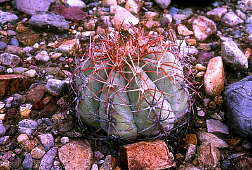
Above: Maverick Mountain
|

Above: In front of Chisos Mountains baisin window pour-off |
Echinocactus horizonthalonius Lemaire 1839 (Eagle's Claw, Devil's Head)
Name: Latin horizonthal = horizontal + halos = flat
The blue-green flattened-globose to cylindrical body is always solitary with typically 8 ribs. The areoles have 5 - 7 radial spines recurved against the body and 3 - 5 erect radial spines. The spiny cage surrounding the plant body often persists after death of the plant and can sometimes be found rolling around in the wind. Flowers are pale pink to magenta with a wooly floral tube, produced in late Spring to early Summer followed by fruits covered in wool.
|
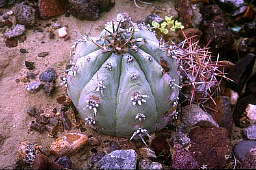 |
Native to the Chihuahuan Desert from Arizona, New Mexico, Texas and into North-Eastern Mexico and quite common in places. Delightful plants in their habitat but very difficult and slow-growing in cultivation.
Left: This specimen of Echinocactus horizonthalonius had rather short stubby spines compared to the rest of the population in the same area. Maverick Mountain, Texas.
|
 |
Echinocactus platyacanthus Link & Otto 1827
Syn. Echinocactus ingens Zuccarini ex Pfeiffer 1837
Name: Greek platyacanthus = with wide thorns
This barrel cactus eventually grows larger than any other, up to 8 ft tall and 5ft wide.
Widely-distributed across North-East and Central Mexico.
|
|
Echinocactus polycephalus Engelmann & J.M. Bigelow 1857
This one of the few barrel cacti that can clump up by offsetting. Large many-headed clumps of this cactus are seen in the hot, dry mountains surrounding Death Valley.
Native to a wide range across the deserts of the USA South-West states of Texas, Arizona, Nevada, California and into Northern Sonora, Mexico.
Photos: Death Valley, California.
|
 
Left: Garden of the Judge Roy Bean Museum & Visitor Centre at Langtry. Right: Limestone escarpment, Langtry.
Echinocactus texensis Hopffer 1842 (Horse Crippler, Devil's Pincushion)
Syn. Homalocephala texensis Britton & Rose 1923
Name: texensis = originates in Texas
A large, solitary flattened disc-shaped cactus with strong pink-brown spines. Each areole has a strong central spine and 6 - 8 radial spines. The wicked upward pointing central spines at the crown of the plant earn this plant its common name. In habitat, the top of the cactus is often nearly flush with the soil with just the spines protruding. Flowers are candy-striped pink
Native to Texas, South-Eastern New Mexico, Olkahoma and the North-Eastern Mexican states of Coahuila, Southern Nuevo León, Durango and Tamaulipas.
|
 Echinocereus Engelmann 1848 (Hedgehog Cacti) Echinocereus Engelmann 1848 (Hedgehog Cacti)
Name: Greek echinos = spiny + Latin cereus = candle
Echinocereus have globular or short columnar bodies with deep ribs, often clumping up by basal offsetting with age. The strong spination, arranged along the apex of the ribs, covers the body and may be quite colourful. The flowers are bright reds, pinks and yellows and quite large in some species.
The monotypic genus Morangaya and some species from Wilcoxia have been transferred into Echinocereus.
|
 |
Echinocereus berlandieri (Engelmann) J.N. Haage 1859
Named for: Jean Louis Berlandier (1805-1851) Belgian naturalist.
The flabby dark green stems have 5 - 7 ribs. The areoles have 1 - 3 brown central spines up to 2cm long and 6 - 9 shorter whiteish radial spines.
Native to the Mexican states of Nuevo León and Tamaulipas and Texas in the USA.
Photo: Holly Gate Cactus Nursery reference collection
|
 |
Echinocereus brandegeei (J.M. Coulter) K. Schumann 1898
Named for: Townshend Stith Brandegee (1843 - 1925) US botanist and plant collector.
The stems offset freely at their base to form large spiny clumps. Fuchsia-pink flowers with darker centres and yellow stigmas are produced in late Summer.
Native to Baja California including the islands in the Gulf of California.
|
  |
Echinocereus chisoensis W.T. Marshall 1940 (Chisos Hedgehog Cactus)
Syn. Echinocereus fobeanus, Echinocereus metornii
Name: From the Chisos Mountains of Texas.
The solitary cylindrical stem has 10 - 16 strong ribs. The areoles have 1 - 6 central spines and 11 - 17 fine radials. The funnel-shaped flower has a woolly floral tube with clusters of spines and is bright pink with a lighter or darker centre, yellow stamens and green stigma.
A rare plant native to the Chihuahuan desert of the Big Bend country of Texas and Northern Mexico.
Photo: Big Bend National Park, Texas, in the presence of Club Chollas.
|
 |
Echinocereus chloranthus (Engelmann) J.N.Haage 1859 (Green Flowered Torch Cactus)
Syn. Echinocereus viridiflorus subsp. chloranthus (Engelmann) N.P.Taylor 1997
Name: Greek chlor = green + anthus = flower
This variable cactus has flowers ranging from green, brown or wine-coloured and dense spination ranging from white to reddish brown.
Native to Western Texas, South-Eastern New Mexico, and Northern Mexico, growing on igneous soils.
Photo: Los Caballos, Brewster County, Texas.
|
 |
Echinocereus coccineus Engelmann 1848 (Strawberry Hedgehog)
Native to South-Western USA, Arizona, California, Colorado, New Mexico, Nevada, Utah, Texas
and the Mexican states of Coahuila, Chihuahua and Sonora.
|
 |
Echinocereus dasyacanthus Engelmann 1848 (Texas Rainbow)
Syn. Echinocereus pectinatus var. dasyacanthus (Engelmann) W. Earle ex N. P. Taylor 1984
Name: Greek dasys = thick + akanthos = thorn
This cactus forms short columns, occasionally offsetting at the base of higher up. The stem has 15 - 20 ribs but these are largely obscured by the dense bristly spines. Areoles produce 16 - 24 radial and 3 - 10 short central spines which vary in colour from white, pale yellow to browns and purple, depending on the growing conditions. Annual growth rings are often marked by spines of different colours. The large yellow flowers with a greenish throat and green stigma make this an exceptionally attractive species. The outer petals may have a darker mid-stripe.
Native to the Chihuahuan desert, Texas, Oklahoma, Southern New Mexico and Northern Mexico, usually on limestone soils.
Photo: Limestone cliffs near Terlingua.
|
 |
Echinocereus davisii Houghton 1931
Syn. Echinocereus viridiflorus subs. davisii (Houghton) N.P.Taylor 1997
Named for: Alva Raymond Davis, Prof. Plant Physiology (1887-1965), discovered this species.
This dwarf cactus has a tuberous root supporting a usually solitary dark green stem up to a 1.5 in tall with 6 - 10 ribs and pale yellow-green lemon-scented flowers in early Spring. Areoles have 8 - 14 radial spines, an occasional single central spine and little wool. The small size and sparse wool on areoles distinguihes this species from Echinocereus viridiflorus.
Native to Brewster County in Trans-Pecos West Texas near Marathon where a small population grows on quartz sandy soil on low, rocky hills. In cultivation, stems grow a little larger up to 3 in with time and may offset, flowering freely at a small size.
|
 |
Echinocereus engelmannii (Parry ex Engelmann) Lemaire 1868
Photo: Holly Gate Cactus Nursery reference collection
|
 |
Echinocereus enneacanthus Engelmann 1848
The soft, green stems initially grow upright, becoming recumbent as they lengthen and offsetting from their base to produce a sprawling clump with a flabby appearance. Stems have 7 - 12 ribs with well-spaced areoles bearing 5 - 9 curved radial spines and 1 - 3 short central spines. In the Spring bright-pink to reddish diurnal flowers are produced. The edible fruits are yellowish-green to reddish and furnished with glochids.
Native to Chihuahuan deserts of New Mexico, Texas and the Northeastern Mexican states of Chihuahua, Coahuila, Durango, Nuevo León, San Luis Potosí and Sonora.
Photo: Big Bend National Park
|
 |
Echinocereus lauii G. Frank 1978
Named for: Dr. Alfred Bernhard Lau (1928 - 2007) German missionary and cactus enthusiast.
This small cactus clumps up by offsetting from its base. The green ribbed stems are mostly obscured by the 20 radial spines and white hairs from each areole. Areoles also produce four central spines. Pink funnel-shaped flowers are followed by spherical greenish spiny fruits.
Native to the Mexican state of Sonora.
|
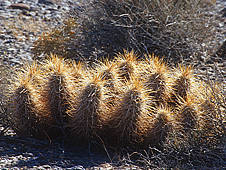 |
Echinocereus nicholii (L.D.Benson) B.D. Parfitt 1987 (Golden Hedgehog, Nichol's Hedgehog)
Syn. Echinocereus engelmannii var. nicholii L.D.Benson 1944
Named for: Andrew Alexander Nichol (1895-1961) American biologist
This rare cactus forms large clumps of stems up to 2 ft tall, with a dense golden spination which marks it out in the field as something different. Areoles are well-spaced and produce 4 - 8 long yellow central spines up to 3 in long and 8 - 12 radial spines. The small flowers are pink and followed by greenish-brown fruit.
Native to Sonoran desert of central Arizona and Northern Mexico.
Photo: 20 miles North of Las Vegas, must be the extreme Northern end of its range.
|
 |
Echinocereus pectinatus (Scheidweiler) Engelmann 1848 (Texas Rainbow)
Name: Latin pectinatus = comb-like referring to the spines
The short columnar green body is usually solitary but old plants may branch. There are up to 30 white to pink radial spines but the central spines are absent or a few very short ones. The funnel-shaped flower is bright pink and followed by a purple-green fruit with dehiscent spines.
Native to South-Western USA, Texas, New Mexico.
Echinocereus pectinatus var. dasyacanthus (Engelmann) W. Earle ex N. P. Taylor 1984
is a taller columnar plant with a large yellow flower.
|
 |
Morangaya G.D. Rowley 1974
Named for: Dr. Reid Moran and Ed & Betty Gay who provided plants and information about the species.
The monotypic genus Morangaya has been merged into Echinocereus.
|
Echinocereus pensilis (Brandegee) J.A. Purpus 1908
Syn. Morangaya pensilis (K. Brandegee) G.D. Rowley 1974
Photographed at Holly Gate Cactus Nursery reference collection
|
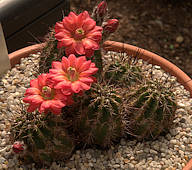 |
Echinocereus polyacanthus Engelmann 1848 (Giant Claret Cup)
Syn. Echinocereus triglochidiatus var. polyacanthus (Engelmann) Benson 1944
Name: Latin polyacanthus = many spined
This variable species forms large clumps of dozens of stems, producing bright red blooms with whiteish throats and rounded petals in Spring to early Summer.
Native to South-Eastern Arizona, Western New Mexico, North-Western Mexico including Baja California.
|
 |
Echinocereus polyacanthus subs. mombergerianus (G. Frank) Breckwoldt 1996
Syn. Echinocereus mombergerianus G. Frank 1990, Echinocereus polyacanthus var. pacificus (Engelmann) N.P.Taylor 1984
Named for: Peter Momberger who dicovered this species
The densely-spined stems clump up to form cushions 2 - 3ft in diameter with over a hundred stems. The red to orange flowers with paler throats and green stigmas are particularly showy.
Native to the Sierra San Pedro Martir of Baja California.
|
 |
Echinocereus roetteri var. lloydii (Britton & Rose) Backeberg 1960
Syn. Echinocereus x lloydii Britton & Rose 1922, Echinocereus x roetteri (Engelmann) Rümpler 1866
This rare plant is probably a natural hybrid Echinocereus pectinatus var. dasyacanthus x Echinocereus coccineus. As such, individual plants may present a variable appearance.
Photographed: N. of Marathon, Texas - April 1990.
|

Above: Dog Canyon, Big Bend National Park, Texas - October 2003

Above: Big Bend National Park, Texas - April 1993.
|
Echinocereus stramineus (Engelmann) F. Seitz 1870 (Strawberry cactus)
Name: Latin stramineus = made of straw
The many light-yellow spines make this clumping cactus look like a pile of old straw, distinguishing it from other Echinocereus, especially the otherwise similar E. enneacanthus. The light green stems have 11- 17 ribs with areoles bearing 7 - 10 radial and 2 - 4 central spines, largely obscuring the plant body. The bright pink flowers with yellow stamens and green stigma are produced in the Spring and are followed by juicy red fruit. Occasional white flowered plants have been reported in the Big Bend National Park.
Native to Trans-Pecos Texas and the Big Bend Country, New Mexico and the Mexican states of Coahuila, Chihuahua, and Nuevo León. The edible fruit are picked and sold in Mexican markets.
|

 |
Echinocereus triglochidiatus Engelmann 1848 (Claret Cup)
Name: Latin tri = three + glochidium = barbed hair or spine
The green body has prominently tuberculate ribs. Despite the name, areoles often have more than 3 straight to curved spines. The grey radial spines (1 - 10) and central spines (1 - 4) are hard to tell apart. This widespread clumping cactus has several named varieties. However, considerable variation may be seen between adjacent clumps. The dark red to orange funnel-shaped flowers, sometimes with a pale base, have pink to purple stamens and a green stigma. Flowers are followed by juicy, edible yellow-green to pink fruit.
Native to Arizona, Southern California, Colorado, New Mexico, Nevada, Utah, Texas, and Mexico, growing on the desert floor and at elevations of up to 11,000 ft above sea level on both igneous and limestone soils. Seen flowering on the top of Emory Peak in the Chisos Mountains.
Photos: Los Caballos, Brewster County, Texas. Note: ants feeding on nectar in the left-hand picture.
|
Echinomastus Britton & Rose 1922
Name: Greek echinos = spiny + mastos = breast, referring to the tubercles.
This genus includes 5 - 9 species of globular to short cylindric cacti with dense spination obscuring the plant body. Stems have grooved tubercles which are sometimes glandular. Diurnal cream, pink to red and brownish flowers are produced from the tips of tubercles near the top of the plant.
Native to the South-Western USA and Northern Mexico. Several former species are now regarded as synonyms.
Some authors include this genus in Sclerocactus.
|

 |
Echinomastus intertextus (Engelmann) Britton & Rose 1922 (Chihuahua Pineapple Cactus)
Syn. Neolloydia intertexta (Engelmann) L.D. Benson 1969
Syn. Sclerocactus intertextus (Engelmann) N.P. Taylor 1987
Name: Latin intertextus = interwoven, referring to the spines
The solitary globular to ovoid plant body with 11 - 13 tuberculate ribs is largely hidden by the interwoven spines. Areoles produce 13 - 25 curved white radial spines and 4 pink to grey central spines. The funnel-shaped flowers are pink or white and followed by spherical green fruit.
Native to a range from South-Eastern Arizona to West Texas and the Mexican states of Chihuahua and Sonora.
Upper left: Granite soil in front of Chisos Mountains, Big Bend National Park, Texas.
Lower left: Limestone soil Dog Canyon area, Big Bend National Park, Tx.
|
 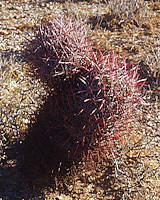
Wasteland near Chloride, Az. |
Echinomastus johnsonii E.M. Baxter 1935 (Johnson's Pineapple Cactus)
Syn. Neolloydia johnsonii (Parry ex Engelmann) L.D. Benson 1969
Syn. Sclerocactus johnsonii (Parry ex Engelmann) N.P. Taylor 1987
Named for: Joseph (Elias) Ellis Johnson (1817-1882) Mormon settler in Utah, amateur botanist, horticulturist & herbalist.
This small barrel cactus has a green body with 18 - 21 ribs, mostly obscured by interlocking reddish-brown spines. Areoles have 4 - 9 central spines and 9 - 16 radial spines. The funnel-shaped flowers are magenta or yellow, followed by greenish fruits.
Native to arid limestone soils of the Mojave deserts of Arizona, California (Death Valley area), Nevada, Southern Utah. Very difficult in cultivation and often grown grafted.
|
 Echinopsis Zuccarini 1837 (Hedgehog Cactus) Echinopsis Zuccarini 1837 (Hedgehog Cactus)
Name: Latin echinos = hedgehog or sea urchin + cacti, referring to the often dense spination
As currently constituted, the genus Echinopsis includes over 128 species of South American cacti with prominment ribs, ranging from small globular plants to tree-like cacti. Flower stems are longer than in Echinocactus and the short-lived relatively large funnel-shaped flowers have wooly, hairy or scaled tubes. Flowers are followed by pulpy fruit which may have a hairy skin.
Native to gravelly soils and rocky hillsides across South America (Argentina, Bolivia, Brazil, Chile, Ecuador, Paraguay, Peru, and Uruguay).
Many former members of former genera e.g. Lobivia, Mediolobivia, Rebutia, Trichocereus have been lumped into Echinopsis. Inter-specific hybridisation is easy within this group and many free-flowering hybrids have been produced.
Lobivia Britton & Rose 1922 Lobivia has been merged into Echinopsis.
Name: an anagram of Bolivia
The genus includes 20 species of small globular plants from the highlands of Bolivia, Peru and Argentina.
The bee-pollinated flowers are brightly coloured with relatively short flower tubes.
Trichocereus (Berger) Riccobono 1909 (Torch Cacti) Trichocereus has been merged into Echinopsis.
Name: Greek trikhos = hair or bristle + Latin cereus = candle
Trichocereus is a group of about 30 columnar plants, which may be erect or decumbent with one hanging epiphytic species.
Some Trichocereus become very large and tree-like. Flowers are typically white and very large with long flower tubes, opening at night for pollination by bats and moths.
Native to Argentina, Bolivia, Chile and Peru. Some species produce toxic psychoactive alkaloids.
|
 |
Echinopsis chamaecereus H. Friedrich & Glaetzle 1983 (Peanut Cactus)
Syn. Chamaecereus silvestrii (Spegazzini) Britton & Rose 1922
Named for: Filippo Silvestri (1873-1949) Italian entomologist & botanist.
This mat-forming cactus has many long thin stems, initially erect but later decimbent, with 8 - 10 ribs profusely furnished with clusters of 10 - 15 small, bristly, radial spines. Peanut-sized offsets are produced along the main stems, detaching rather easily to start new plants. Funnel-shaped orange flowers are produced freely in late Spring and sporadically later on.
Native to the Andean mountains of Argentina and moderately frost-hardy when dry. Features in many colourful hybrids with other Echinopsis, especially Lobivia species with the hybrids known as Chamaelobivia. Echinopsis chamaecereus f. aureus is a yellowish chlorophyll-deficient mutant commonly seen grafted.
|
 |
Echinopsis comarapana Cárdenas 1957
Name: from Comarapa in the Bolivian province of Vallegrande.
This cactus has short cylindrical gray-green stems with ten - twelve ribs bearing grayish areoles with one central spine and 9 - 11 thin radial spines. By offsetting, this cactus clumps up to form large cushions. The relatively-large flowers are white and funnel shaped.
Native to the Bolivian department of Santa-Cruz.
|
 |
Echinopsis formosa (Pfeiffer) Jacobi ex Salm-Dyck 1850
Name: Latin formosa = well formed, handsome
A commonly solitary cactus, offsetting from the base with maturity. The light-green body has 27 - 50 ribs with areoles producing 9- 15 slightly curved radial spines and 2 - 9 brown central spines. The funnel-shaped flowers are bright yellow, orange to red.
Native to Argentina and Chile.
|
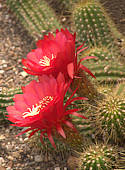  |
Echinopsis huascha (Weber) Friedrich & G.D.Rowley 1974 (Red Torch Cactus, Argentine Hedgehog)
Named for: location in North-Western Argentina.
This cactus grows upright at first, then becomes decumbent as the spiny, ribbed stem elongates. Stems typically have 14 - 17 ribs and areoles with 9 - 11 radial spines and 1 - 3 needle-like brown central spines. Basal offsetting produces a mat of sprawling stems. Flower colours range from golden-yellow to orange and red. Flower tubes are scaly with long brown hairs.
Native to Argentina and Bolivia.
|
 |
Echinopsis pygmaea R.E. Fries 1905
Syn. Lobivia pygmaea (R. E. Fries) Backeberg 1935, Mediolobivia eos var. roseiflora Rausch 1972, Rebutia pygmaea (R. E. Fries) Britton & Rose 1922
This variable species has many (>60) synonyms. Current fashion favours Echinopsis.
Native to Bolivia and Argentina.
|
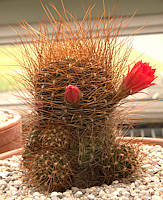 |
Echinopsis schieliana (Backeberg) D. R. Hunt 1987
Syn. Lobivia schieliana Backeberg 1957
Named for: German cactophile Wolfgang Schiel (1904-1978)
This small cactus forms clumps of dark reddish-green globose to cylindrical bodies, spidery golden spines and light red or dark gold flowers.
Native to a small area of North-West Bolivia (La Paz) and Peru, at altitudes arouind 10,000 ft above sea level.
|
 |
Echinopsis spiniflora (K. Schumann) A.Berger 1929
Syn. Acanthocalycium spiniflorum (K. Schumann) Backeberg 1935
This cactus is usually solitary but may offset at its base. The dark green globular body has 9 - 15 ribs with areoles covered in brownish fluff and producing dark 5 - 10 brown to grey radial spines and 1 - 4 central spines. Flowers are white or shades of pink with yellow stamens. Flower buds and floral tubes are very hairy and scaly.
Native to Argentina.
|
 Epiphyllum Haworth 1812 (Orchid Cactus) Epiphyllum Haworth 1812 (Orchid Cactus)
The genus Epiphyllum includes 19 species of epiphytic cacti with broad, flat photosynthetic stems, often with lobed or notched margins. These epiphytic cacti grow hanging from trees or rock faces and obtain their nutrient from dead leaf litter and bird droppings. Their short-lived flowers open at night and are white to red with many petals and long flower stems. Most species have strongly-perfumed flowers to attract moths and bats as pollinators. Flowers are followed by relatively large edible fruit with small black seeds in a juicy pulp whick may be white or pink to purple.
Native to Central and South American rainforests from Mexico to Brazil and to some Caribbean islands. Some species have become naturalised in moist tropical climates outside their native range e.g. Florida.
Note: many plants known as "Epiphyllums" in the horticultural trade are hybrids of species from other genera.
See: Epi Hybrids
|

Photo: Cindi Powell 2015. |
Epiphyllum hookeri Haworth 1829 (Hooker's Orchid Cactus)
Named for: Sir William Hooker (1785 - 1865) Director of Royal Botanic Gardens, Kew.
This species has wide flat stems with notched margins, a pronounced central mid-rib and occasional narrow triangular stem sections. The large white flower has many narrow petals with white stamens, and a yellow stigma with a purple tube. The fragrant blooms open at night.
Native to Central American and Caribbean rainforests including Belize, Costa Rica, El Salvador, Guatemala, Honduras, Mexico, Nicaragua, and Panama. It is also naturalised in Florida USA.
|


Photos: Richard Houghton 2000. |
Epiphyllum oxypetalum (de Candolle) Haworth 1829 (Queen of the Night)
Named for: Sir William Hooker (1785 - 1865) Director of Royal Botanic Gardens, Kew.
This Epiphyllum has a cylindrical stem branching at its end into wide flat pendulous stems with a midrib and notched margins. The large white flower has many narrow petals with white stamens, and a white stigma. The sweetly fragrant blooms open at night.
Native to tropical rain-forests of Central and South America including Mexico, Venezuela and Brazil and naturalised in other moist tropical climates. Typically grows hanging from trees and this lifestyle makes it suitable for hanging baskets.
|
|
Epi hybrids
The plants commonly known in the horticultural trade as Epiphyllums are usually hybrids between members of the genera Disocactus, Pseudorhipsalis and Selenicereus with Epiphyllum species occuring less frequently in the parentage. Epi hybrids have flattened notched leafless stems, with areoles found in the notches sometimes bearing a few short very fine vestigial spines. The large flowers are white, yellow, orange to red, often opening at night, sometimes highly perfumed.
|
 |
Epi hybrid
This hybrid has a large white flower with brownish-yellow sepals that opens at night but usually lasts for two or three days. The flowers produce a very strong perfume of lilies in late evening into the night.
Of garden origin, but the parental species originate in the South American rainforests. Tolerates a cold dry Winter but no frost.
|
 |
Epi hybrid cv. 'Reichskanzler Adolph Hitler'
A night-perfumed red flower with subtle hints of lilac inside that makes an interesting change from all-red flowers.
A variety raised by the German Epicacti hybridizer Curt Knebel in 1935. Renamed by the American Epiphyllum Society to 'Sherman E. Beahm' and known by some as 'Flying Fortress'. Original cutting obtained from the late Holly Gate Cactus Nursery.
|
Epithelantha Britton & Rose 1922
Name: Greek epi = upon + thele = nipple + anthos = flower, referring to the flower position near a tubercle apex
The genus includes 2 species of tiny, button-like cacti, E. micromeris and E. bokei. In their harsh habitat these cacti rarely exceed an inch in diameter. Their green bodies are covered with white pectinate spines. The small pale pink flowers are followed by elongated red fruits full of black seeds.
In cultivation Epithelantha often become unnaturally bloated cylindrical stems and white fluff accumulates, particularly around the top of the plant. In nature, this would be washed away by rain.
|

Photo: Carlsbad Caverns Natl. Park, Guadaloupe Mountains. NM.
|
Epithelantha micromeris (Engelmann) Britton & Rose 1922 (Button cactus)
Name: Greek mikros = small + meros = parts, referring to the spines
This tiny globose cactus occurs singly or in small groups, often in cracks in rocks and between gravel. The body is green with many very small tubercles but the high density of pectinate spines gives it a rough grey-white appearance. The stems often have a flat or concave centre. Tiny pink flowers are produced from near to the apex of tubercles at the top of the stem and are followed by eliptical or elongated shiny red fruits.
Widely spread across Arizona, New Mexico, Western Texas and the Mexican state of northern Chihuahua, often growing on limestone.
|
 Escobaria Britton & Rose 1923 (Pincushion Cactus, Foxtail Cactus) Escobaria Britton & Rose 1923 (Pincushion Cactus, Foxtail Cactus)
Named for: Rómulo Escobar Zeeman (1882 - 1946) & Numa Pompilio Escobar Zerman (1874 - 1949), Mexican agronomists
Escobaria is a genus of 23 species of small cacti native to North America. The plant bodies are flattened spheroids to short cylindrical columns, without ribs but with prominent tubercles which may become corky and shrivel with age. Spines are never hooked. Flowers in white, yellow pink or purple are produced near to the growing point. Escobaria are similar to Coyphantha but their seeds have a pitted surface rather than a reticulate one.
Native to a large range from Canada into Northern Mexico. A single species is native to Cuba.
|
 |
Escobaria albicolumnaria Hester 1941 (Silver-Lace Cob Cactus)
A solitary cactus growing as a short column up to 10in tall. Plants occasionally branch and becomemulti-stemmed. Tubercles are grooved. Areoles produce 25 - 30 white radial spines and 11- 15 central spines. The small flowers are pink with a darker mid-stripe on the petals and are followed by yellowish-green fruits.
Native to limestone of Brewster County, Texas
Photo: On limy conglomerate above Boquillas Canyon, Big Bend National Park, Texas.
|
 |
Escobaria hesteri (Y. Wright) Buxbaum 1951
Photo: South of Marathon, Texas.
|
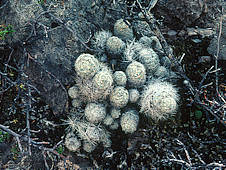
|
Escobaria sneedii Britton & Rose 1923 (Sneed's pincushion cactus)
Named for: J.R. Sneed, plant collector.
This small clumping cactus has prominent irregular white spines obscuring the green body. Flowers are bright to dull pink.
A rare plant thanks to over-collecting. Native to New Mexico, Texas, and the Mexican state of Chihuahua. Type locality is the Franklin Mountains of Texas.
Photo: Guadelupe Mountains National Park, Texas
|
|
Escobaria leeii ssp. leei (Rose ex Bödecker) D.R.Hunt 1997 (Lee's pincushion cactus)
Syn. Escobaria sneedii Rose ex Bödecker 1933
Named for: Willis T. Lee, geologist who surveyed the park and collected this plant in 1925
This cactus grows in large clumps of small stems with white spines obscuring the green body. Flowers are pale pink.
It appears to be a juvenile (neotenic) form of E. sneedii.
Native to the Guadelupe Mountains of New Mexico, typically growing in cracks in limestone ridges and paving. It is rare through a very limited distribution within the Carlsbad Caverns National Park, but locally quite prolific.
Photos: Carlsbad Caverns National Park, Guadelupe Mountains, NM.
|
 |
Escobaria missouriensis (Sweet) D.R. Hunt 1978
Photograph: Robin Howard, Cheyenne Mountain State Park, Colorado. June 2008
|
 |
Escobaria tuberculosa (Engelmann) Britton & Rose 1923
This is the type species for the genus.
West of Terlingua, Texas.
|
 |
Escobaria tuberculosa (Engelmann) Britton & Rose 1923
Photo: Dog Canyon, Big Bend National Park, Texas.
|
 |
 |
Escobaria tuberculosa (Engelmann) Britton & Rose 1923
Photos: cultivated plants.
|
 |
Escobaria vivipara (Nuttall) Buxbaum 1951 (Spinystar Cactus)
Native to a wide range of Northern America from Canada into Mexico.
Photo: Escobaria vivipara in fruit. Marathon, Texas.
|
 Ferocactus Britton & Rose 1922 Ferocactus Britton & Rose 1922
Name: Latin ferox = fierce + cactus
The genus Ferocactus includes about 25 species of large barrel cacti with deeply ribbed bodies and strong spines.
With age, some species form 10ft columns. Ribs may be straight or tuberculate. The yellow or red flowers are produced around the growing point and are relatively small for the body size. Flower buds are scaly without spines or hairs. The typically-elongated yellow fruits contain many hard black or brown seeds.
Native to the South-Western USA and North-Western Mexico. Many Ferocactus species have extrafloral nectaries above each areole. The nectar is attractive to ants which form colonies around the base of the plant and in return for nectar, help to protect the cactus and keep it clean. However, in cultivation sugary nectar exuded from the nectaries makes Ferocacti prone to black mould.
|
 |
Ferocactus acanthodes Britton & Rose 1922 (Compass Barrel Cactus)
Syn. Ferocactus cylindraceus (Engelmann) Orcutt 1926
Name: Greek akanthodes = spiny
A usually solitary columnar (8ft) cactus with prominent ribs obscured by four straight to curving pink to grey central spines and 8 to 28 lighter colored fine radial spines from each areole. One of the central spines is usually especially long (5in) and curves down. Flowers are greenish yellow, occasionally tinged with red and are followed by yellow fruit.
This cactus is native to the Eastern Mojave Desert and Western Sonoran Desert of Southern California, Nevada, Arizona, and Utah, Baja California, and the Mexican state of Sonora state. Plants may lean towards the South-West and in some cases fall over and continue to grow along the ground.
|
 |
 |
Ferocactus glaucescens (de Candole) Britton & Rose 1922 (Blue Barrel Cactus)
Name: Latin glaucescens = glaucous
This strongly-ribbed cactus can remain solitarry or with maturity form large clumps by basal offsetting.
Spination seems variable from 6 - 7 radial and 1 central spine, to no spines (forma nuda). The yellow, funnel-shaped flowers are quite long lasting. Petal margins are irregular.
Native to the Mexican state of Hildago, growing among limestone rocks in juniper woodland at up to 4000ft above sea level.
|
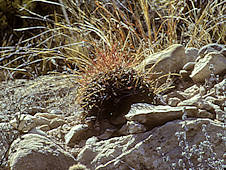 |
Ferocactus haematacanthus (Monville ex Salm-Dyck) Bravo ex Backeberg & Knuth 1935 (Texas Barrel)
Name: Latin hamatus + Greek akanthos = hooked spine
This is the only barrel cactus native to Texas, reaching a height of about 4 ft, although usually seen at a much smaller size. The solitary globular green body has 13 - 17 ribs with closely-spaced areoles bearing 6 - 7 radial spines and 4 long hooked central spines.
Native to the Chihuahuan Desert of South-Western Texas, New Mexico and North-Western Mexican states of Puebla and Veracruz, usually on limestone soils.
Photo: Black Gap Wildlife Management Area, Texas.
|
 |
Ferocactus hystrix (De Candole) G.E. Lindsay 1955 (Electrode Cactus, Candy Barrel Cactus, Mexican Barrel Cactus )
Syn. Echinocactus electracanthus de Candole 1828
Name: Latin electra + Greek akanthos = yellow (amber) spines, hystrix = spiny
A solitary globular barrel cactus growing up to 4ft tall with a green ribbed (20 - 40) body, a wooly central top and 10 - 12 amber-yellow spines with a reddish base arising from wooly areoles. There are 1 - 4 stout central spines and 6 - 9 less stout radial spines.
Native to arid highlands of central Mexico where it is common in forests and scrub at 4000 - 8500 ft above sea level. This cactus is used in the candy industry. The flower buds and fruits are also eaten and the fruits are fermented to an alcoholic drink.
|
 |
 |
Ferocactus pilosus (Galeotti ex Salm-Dyck) Werdermann 1933 (Mexican Lime Cactus, Mexican Fire Barrel)
Name: Latin pilosus = shaggy
This large, solitary or clumping barrel cactus has a strongly ribbed, bright green body contrasting with strong red central spines. Radial spines are either absent or reduced to white fibres which on some plants may be plentiful. Becoming columnar (8ft) with age, this cactus may offset low down to form a group of short columns. Flowers are red to yellow with a scaly ovary and are followed by yellow fruit.
Native to limestone soils over a wide range in the Mexican states of Nuevo León, San Luis Potosí, Coahuila and Zacatecas.
|
 |
Ferocactus schwarzii Lindsey 1955
Named for: Friedrich (Fritz) Schwarz (1900 - 1988) German botanist who first collected this species.
This large, solitary barrel cactus becoming a short column (3ft) with age, has a deeply ribbed, bright green body. Areoles along the ribs have some white felting and 4 - 5 needle-like yellow central spines which become fewer as the plant matures. Flowers are yellow with a scaly ovary and are followed by brownish fruit.
Native to the central Mexican state of Sinaloa.
|
 |
Ferocactus wislizenii (Engelmann) Britton & Rose (Candy Barrel Cactus, Fishhook Barrel Cactus)
Named for: Friedrich Adolph Wislizenus (1810-1889) German-born American physician, explorer and botanist.
This large, solitary barrel cactus has a strongly ribbed (20 - 28), green body largely obscured by 3 - 4 strong red central spines at least one of which is flattened and hooked and 12 - 20 fine white radial spines. Spination is strongest in full sun and weaker in the shade and in cultivation. This species becomes a short column (6ft) with age, typically leaning towards the South-West. Flowers in late Spring to early Autumn are orange-red with a scaly ovary and are followed by edible yellow fruit.
Native to the Sonoran and Chihuahuan deserts of South-Eastern Arizona, East to Southern New Mexico and East Texas and Northern Mexico. Locally prolific in some areas. Chunks of this cactus are preserved with sugar as a sweetmeat. The seeds have been used by indians to make flour and the spines as fish hooks.
|
 Gymnocalycium Pfeiffer ex Mittler 1844 Gymnocalycium Pfeiffer ex Mittler 1844
Name: Greek gymno = naked + kalyx = bud
Gymnocalycium includes about 70 species of small globose, usually solitary cacti. Flower buds are smooth and scaled without spines or hairs.
Native to Argentina, Southern Bolivia, Brazil, Paraguay and Uruguay. These cacti are popular for their brightly coloured flowers.
|
 |
Gymnocalycium achirasense H.Till & Schatzl 1987
Syn. Gymnocalycium monvillei Pfeiffer ex Britton & Rose subsp. achirasense (H.Till & Schatzl) H.Till 1993
Native to Northern Argentina.
Photo: Holly Gate Cactus Nursery reference collection
|
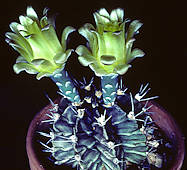 |
Gymnocalycium friedrichii (Werdermann) Pazout 1964 (invalid name)
Syn. Gymnocalycium mihanovichii Frič ex Gürke) Britton & Rose 1922
Native to Bolivia, Paraguay and Argentina.
|
 |
Gymnocalycium gibbosum (Haworth) Pfeiffer ex Mittler 1844
This is the type species of the genus Gymnocalycium.
Native to Argentina.
|
 |
Gymnocalycium lafeldense Vaupel 1924
Syn. Gymnocalycium bruchii (Spegazzini) Hosseus 1926
Native to Western Argentina.
|
 |
Gymnocalycium monvillei ssp. horridispinum (G.Frank ex H.Till) H.Till 1993
Syn. Gymnocalycium horridispinum G.Frank ex H.Till 1987
Named for: M. Chevalier de Monville (1794 - 1863) French botanist
Native to Argentina.
|
 |
Gymnocalycium parvulum Spegazzini 1925
Name: Latin parvulum = very small
This is a small plant whose greenish-brown body has 9 - 13 ribs with areoles producing 5 - 7 radial spines and no central spines. The funnel-shaped flowers are white with a reddish-purple throat.
Native to Argentina.
|
 |
Gymnocalycium pflanzii (Vaupel) Werdermann 1935
Named for: Karl Pflanz (1872-1925) German botanist and plant collector.
Native to Bolivia, Paraguay and Argentina.
|
 |
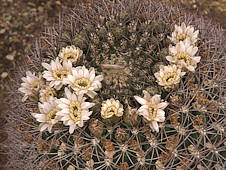 |
Gymnocalycium saglionis (Cels) Britton & Rose1922
Named for: Joseph Saglio, French cactus collector
This solitary barrel cactus has a dark green body up to 3ft tall and with 10-30 ribs. Areoles produce 10 - 15 red to black radial spines recurved towards the body and 1 - 3 curved central spines. Pale pink to white flowers are produced in a ring around the top of the plant thoughout the growing season. the globular red fruit are spontaneously dehiscent, revealing many dark brown seeds.
Native to Northern Argentina.
|
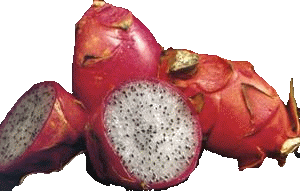
 Hylocereus (A.Berger) Britton & Rose 1909 Hylocereus (A.Berger) Britton & Rose 1909
Name: Greek hyle = "forest" + cereus = "candle, waxy"
This group of South American cacti is closely related to Selenicereus. These cacti root down in the ground and their thick 3-angled stems scramble over rocks, bushes and trees. Some species e.g. Hylocereus undatus, produce large scaly edible fruits, sold commercially as pitahaya or dragon-fruits. The large flowers usually open for just one night. Many hybrids have been created to improve fruit production or for their flowers.
|
 |
Hylocereus costaricensis (F.A.C. Weber) Britton & Rose 1909 (Costa Rica Night Blooming Cactus)
Syn. Hylocereus polyrhizus - garden origin
Name: Native to Costa Rica
This cactus has thick, green angular stems with well-spaced areoles along the wavy margins but with few spines. The stems are usually rooted in the ground and scramble through bushes and trees. The large perfumed cream-coloured flowers open mainly at night and are followed by red fruit with purple pulp and many tiny black seeds.
Native to South America and the Caribbean, Costa Rica, Nicaragua to Peru
|
 Lepismium Pfeiffer 1835 Lepismium Pfeiffer 1835
Name: Greek lepis= scale, referring to a small scale under the areole.
The genus Lepismium includes about 12 species of epiphytic cacti from South America. The flattened to angled or rounded stems branch frequently from the middle of the stem. Relatively small white, pink or orange flowers are produced along the length of the stem, followed by juicy white to red berries.
Native to tropical rainforests of Bolivia, Brazil and Argentina, so require more frequent watering than most cacti. This genus includes species formerly in Acanthorhipsalis (K. Schumann) Britton & Rose and Pfeiffera Salm-Dyck, although inclusion of the latter is controversial.
|
 |
Lepismium ianthothele (Barthlott & Rauh) Barthlott 1987
Syn: Pfeiffera ianthothele F.A.C. Weber (1898)
Name: Greek ianthos = violet + thele = warts, referring to the fruits.
This sprawling epiphyte has soft, 3 - 5 angled stems with well-spaced areoles funished with 6 - 7 spines. The white flowers produced in early Summer are followed by purple-pink berries.
Native to South-East Bolivia.
|
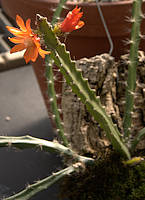 |
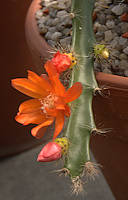 |
Lepismium miyagawae (Barthlott & Rauh) Barthlott 1987
Syn. Pfeiffera miyagawae Barthlott & Rauh 2002
Named for: Mario Miyagawa who collected this species.
This sprawling epiphyte has soft, 3 - 5 angled stems with well-spaced areoles producing white wool, bristles and soft white spines. The orange flowers produced in the Spring are quite big for the genus and have a spiny ovary and pericarp. Fruit are white.
Known from 2 collections in Dept. Cochabamba, Bolivia.
|
 Lophophora J.M. Coulter 1894 (Peyote Cactus) Lophophora J.M. Coulter 1894 (Peyote Cactus)
Name: Greek lophos = crest + phoreo = to carry
The genus Lophophora includes up to 4 species of bluish-green to gray button-like cacti with 5 - 8 ribs, whose spines have degenerated into tufts of hairs from each areole.The plant is supported by a large taproot. With age, individual heads can reach 6 in across and can offset at their base to form a clump. Flowers are produced from the growing point and as these plants are self-fertile, may be followed by elongated pink fruit.
Native to a range from South-Western USA into central Mexico. In cultivation they are quite free-flowering. These cacti, especially Lophophora williamsii, contain mescaline, pellotine and other toxic alkaloids and feature in Indian-American rituals. This is the "Divine Cactus" as described by Anderson.
|
 |
 |
|
Lophophora williamsii (Lemaire ex Salm-Dyck) J.M. Coulter 1894
Named for: Sir. C.H. Williams, British Ambassador to the state of Bahia, Brazil
The plant body is a blue-gray button divided into ribs by incised lines and with tubercles marked by tufts of wool. Small pink flowers are produced freely from the centre of the body. The thick tap-root is a little sensitive to excessive watering.
Photos: West of Terlingua, Texas.
|
 Mammillaria Haworth 1812 (Nipple Cactus) Mammillaria Haworth 1812 (Nipple Cactus)
Name: Latin mammilla = nipple, referring to the distinctive tubercles.
The large genus Mammillaria includes 171 species of small cacti with distinctive tuberculate aereoles, the apex of which bears spines and the base of which is spineless but may be woolly or have bristles. The base of the aereole also bears the flowers and fruits. The spines are quite variable between species and may be straight or hooked. Most species are spheroidal, or with age form short columns up to 8 inches tall. Many species have small pink flowers, or small yellow or white flower. Just a few have relatively large showy flowers. Flowers are typically folllowed by small, tubular red fruit.
Most Mammillaria are native to Mexico but also to the South-Western USA, the Caribbean islands, Colombia, Guatemala, Honduras, and Venezuela. This genus of cacti is popular and easy in cultivation and many species flower freely on a sunny window ledge.
|
 |
Mammillaria bocensis Craig 1945
Name: found near to Las Bocas, Sonora, Mexico
The globose to cylindrical dark green body mostly remains solitary but old plants may cluster. Each tubercle produces 6 - 8 radial spines with reddish-brown tips and a single central spine. Flowers are greenish-yellow to pale pink with a darker brownish stripe along the petals and a bright green style. They are followed by club-shaped red fruit.
Native to the Mexican states of Sonora, Sinaloa, Jalisco and Nayarit, growing in coastal salty flats and scrub and up to 300ft above sea level.
|
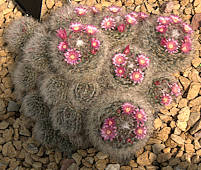
M. bocasana
(pink flower) |
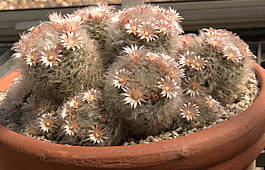
M. bocasana
(intermediate flower) |

M. bocasana
(yellow flower) |
|
Mammillaria bocasana Poselger 1853 (Powder Puff Cactus)
Name: found in Sierra de Bocas Mountain range, San Luis Potosí, Mexico
This popular fast-growing, clumping cactus has bluish green tuberculate stems that are mostly obscured by clusters of long silky white hairs and a single (rarely two) long reddish-brown fish-hook spine from each tubercle. Flowers may be pink or yellow and are followed by cylindrical pink fruit. There are several selected cultivars with differing amounts of hairs and flower colour.
Native to the central Mexican states of San Luis Potosi, Queretaro and Zacatecas at altitudes of up to 7500 ft above sea level. This is a very easy freely-flowering cactus to grow and if potted on will soon form a nice clump. It is best watered from below as the silky white hairs become matted otherwise.
There is a cristate form of Mammillaria bocasana which continues to flower nicely with pink flowers along the crest. Mammillaria bocasana cv. Fred is a monstrose cultivar that over time has diversified into several clones with weird shapes.
|
 |
 |
Mammillaria candida Scheidweiler 1838 (Snowball cactus)
Syn. Mammilloydia candida (Scheidweiler) Buxbaum 1951
Syn. Neomammillaria candida (Scheidweiler) Britton & Rose 1923
Name: Latin candida = white
This globular cactus, becoming cylindrical with age, is covered with fine white hair and many short, white or brown spines. Each tubercle can produce as many as 120 radial spines. Old plants can form large clumps. The flowers are pale yellow to pale pink with a darker stripe along the middle of the petals.
Native to the Mexican states of Coahuila, Nuevo León, San Luis Potosí and Tamaulipas, growing on limestone soils and rocks at altitudes of 1,600 - 8,200 ft above sea level. In cultivation, ground limestone can be added to the soil.
|
 |
Mammillaria dixanthocentron Backeberg 1963
Name: Greek di = two + xanthos = yellow + kentron = center, referring to the two central spines
The globose dark green body is obscured by 19 - 20 white radial and 2 -4 white to brown central spines with dark tips. Some cultivated forms have been selected for exceptional length of the central spines and different spine colours. The small flowers are pink to red and are followed by orange club-shaped fruit.
Native to the Mexican states of Oaxaca and Puebla at altitudes of up to 6500 ft in dry deciduous forests and clinging to cracks in rocks.
|
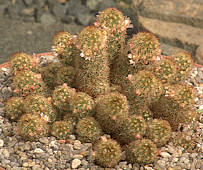 |
Mammillaria elongata De Candole 1828 (gold lace cactus, ladyfinger cactus)
Name: Latin longus = long, referring to elongated stems
The cylindrical stems have spirally-arranged conical tubercles with 14 - 25 golden radial spines and few or no central spines. The interlocking spines form a mesh covering the stems. Many small cream-coloured flowers (sometimes flushed with pink) are produced in the Spring and are followed by cylindrical red fruit. As the stems elongate they become prostrate. Roots are fibrous.
Native to the central Mexican states of Hildago, Guanajuato, and Queretaro. Named cultivars have been selected on the basis of different spine colours from dark brown to white, and a cristate form is sometimes seen. |
 |
Mammillaria formosa Galeotti ex Scheidweiler 1838
Name: Latin formosa = well designed
The globose green bodies have prominent tubercles with 2 - 6 central spines and very fine radial spines. Axils are woolly, especially around flowers. Flowers are pale pink with a darker stripe along the middle of the petals. By dichotomous division of plant bodies and offsetting, this species can form large clumps.
Native to the Mexican states of Coahuila, Aguascalientes, Guanajuato, Zacatecas, Tamaulipas, Nuevo León and San Luis Potosí, Mexico.
|
 |
Mammillaria glassii R.A. Foster 1968
Named for: Charles Edward Glass (1934-1968) American horticulturalist & plant collector
This small mat-forming cactus offsets freely to form fluffy white clumps. The short globose stems have areoles that produce 50 - 60 hair-like radial spines and 1 - 4 hooked or straight central spines. The axils also produce 10- 20 white bristles. The small, funnel-shaped flowers are pale yellow to pale pink and are followed by bright red, oval fruit filled with black seeds.
Native to the Sierra Madre Oriental mountain range across the Mexican states of Coahuila, Nuevo León and Tamaulipas, growing at altitudes of 4750 - 7400 ft above sea level. If kept dry, will tolerate light frost.
|

|
Mammillaria gracilis Pfeiffer 1838
Syn. Mammillaria vetula subsp. gracilis (Pfeiffer) D.R. Hunt 1997
Small (1 - 2 in long) cylindrical green bodies are covered with white spines with 11 - 16 radial spines and 0 - 5 central spines from each areole, with centrals especially on mature stems. The stems offset freely along their length. Offsets detach very easily, but every one will root and form a new plant. The small pale yellow flowers have a darker mid-stripe and are followed by pink fruit.
Native to the Mexican states of Hilalgo and Queretaro,growing at up to 6000 ft above sea level. This cactus certainly tolerates some frost if dry, but not cold-wet conditions.
Various selected spine variants are in cultivation e.g. "Arizona Snowflake / Snowcap". |
 |
Mammillaria gracilis, possibly the cultivar "Arizona Snowflake / Snowcap"
dyed purple and marketed under the trade name Kosmic Kaktus.
A range of other colours are available. New growth will have the gleaming
white spines of the original plant so if you buy one of each colour, those
that grow will eventually all look the same.
Photo: Andrea Hüper, 2014.
|
 |
Mammillaria grusonii Runge 1889
Named for: Hermann August Jacques Gruson (1821 - 1895) German engineer & cactus collector
Native to the Mexican states of Coahuila and Durango.
Photo: Holly Gate Cactus Nursery reference collection
|
 |
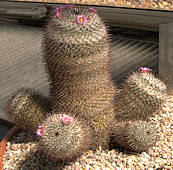 |
Mammillaria haageana Pfeiffer 1836 (Mexican Pincushion Cactus)
Named for: Friedrich Adolph Haage de Erfurt (1796 - 1866) German botanist
This is a solitary or occasionally clumping globose cactus. Old plants may produce basal offsets. The axils produce abundant wool. Tubercles have 16 - 18 fine white radial spines and 1 - 2 stout grey-brown straight central spines. Flowers are pink to magenta-pink with a darker midstripe, produced in a ring around the top of the plant.
Native to a wide range in the Mexican states of Veracruz, Puebla, México, Morelos, Oaxaca and Ciudad de México.
|
 |
Mammillaria hahniana Werdermann 1929 (Old Lady Cactus)
Named for: Adolf Hahn (b. 1954) German cactus collector from Berlin
The axils of some clones produce white hairs up to 1.5 in long that cover the globose to cylindrical green plant body. Nurserymen tend to propagate extreme forms but this is unreprentative of the wild population. The areoles have 20 - 30 hair-like radial spines and 1 - 4 short white central spines with darker brown tips. Flowers are in shades of pink.
Native to the central Mexican states of Guanajuato, Querétaro Arteaga and Tamaulipas.
Photo: Holly Gate Cactus Nursery reference collection
|

Dog Canyon, Big Bend National Park, Texas. |
Mammillaria heyderi Muehlenpfordt 1848
Named for: Privy Councellor Eduard Heyder (1808-1884) German cactus expert from Berlin
Native to Oklahoma, New Mexico and Texas USA and the Mexican states of Tamaulipas, Nuevo León, Coahuila, Durango, Sonora, San Luis Potosí and Veracruz.
|
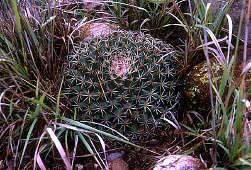
West of Terlingua, Texas. |

Big Bend National Park, Texas. |
Mammillaria heyderi subsp. meiacantha (Engelmann) D.R. Hunt 1997
|
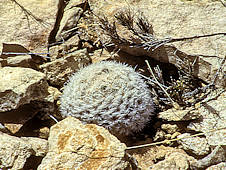 |
Mammillaria lasiacantha Engelmann 1856
Name: Greek lasios = hairy + akanthos = spine
This mature Mammillaria lasiacantha is only about 1.5in in diameter. The plant body is entirely obscured by a lacy mat of white spines. Areoles produce 40 - 80 smooth to plumose radial spines held against the plant body and no central spines.
Small cream flowers, whose petals have a green, yellow, pink to pale purple mid-stripe, are produced in late Winter to early Spring.
Native to Chihuahuan desert limestone soils in Texas and New Mexico and the Mexican states of Chihuahua, Coahuila, Durango, Nuevo León, San Luis Potosí, Sonora and Zacateca.
Photo: Limestone cliffs above and to the South of Terlingua.
|
 |
Mammillaria longimamma A.P. de Candolle 1828
Syn. Dolichothele uberiformis (Zuccarini) Britton & Rose 1923
Name: Latin longimamma = long nipple
Thick taproots support a light green stem with long, soft tubercles. The main stem forms a clump by basal offsetting. Areoles produce 8 - 10 long pale brownish radial spines and a single long straight central spine. Flowers, produced from the axils, are yellow with a yellow stigma and relatively large and are followed by yellowish fruit.
Native to the Mexican states of Hidalgo and Querétaro. In cultivation a deep pot is advisable to accommodate the tap root and a very free-draining potting mix and careful watering are advisable. A single whole tubercle is sufficient to propagate this cactus.
|
 |
Mammillaria microhelia Werdermann 1930
The short (6 in) cylindrical body is hidden by 30 -50 fine white radial spines with a pectinate arrangement and 1 - 4 brown central spines from each tubercle. Plants may be solitary or clump up by basal offsetting. Flowers are pale yellow or pink.
Native to a limited range in the Mexican state of Querétaro, growing among volcanic rocks. Easy in cultivation.
|
 |
Mammillaria perezdelarosae H. Bravo & L. Scheinvar 1985
Syn. Mammillaria bombycina ssp. perezdelarosae (Bravo & Scheinvar) D.R. Hunt 1997
Named for: Jorge Perez de la Rosa (b. 1955) Mexican forestry specialist, Secretary of Botanical Institute of University of Guadalajara.
This slow-growing solitary or clumping cactus has globose tuberculate stems, becoming cylindrical. The areoles produce 30 - 60 very fine white radial spines in a pectinate arrangement and 1 -2 reddish-brown, hooked central spines. Flowers are greenish white to pale pink with a darker mid-stripe, followed by red fruit containing dark brown seeds.
Native to the Mexican states of Jalisco and Aguascalientes. |
 |
Mammillaria pottsii
Native to
Photo: Limestone cliffs above and to South of Terlingua.
|
 |
Mammillaria prolifera (Miller) Haworth 1812 (Texas Nipple Cactus)
Widely distributed from Texas into the Mexican states of Coahuila, Nuevo León, Querétaro, San Luis Potosí & Tamaulipas. Also in Cuba, Dominican Republic & Haiti.
Photo: cultivated plant.
|
 |
Mammillaria schiedeana Ehrenberg 1838
This small cactus forms multiheaded clumps up to 2 in high. The globose to cylindrical stems are hidden by a mesh of pale yellow spines. Flowers are white to pale pink, sometimes with a darker mid-stripe and are followed by bright red cylindrical fruits. Roots are fleshy so need good drainage.
Native to the Mexican states of Hidalgo, Queretaro de Arteaga, San Luis Potosi and Tamaulipas. Likes a limestone soil.
|
 |
Mammillaria surculosa Bödeker 1931
Syn. Dolichnthele surculosa (Bödeker) Backeberg 1951
This dwarf globular dark-green cactus soon clumps up to form a mat. The areoles produce 15 radial white spines and 1 - 2 golden hooked central spines. There is a fleshy taproot. The small funnel-shaped yellow flowers are lightly perfumed and are followed by brownish fruit.
A rare plant, native to the Mexican states of San Luis Potosí and Tamaulipas growing at 9800 - 10500 ft above sea level. It is widely propagated in the horticultural trade.
|
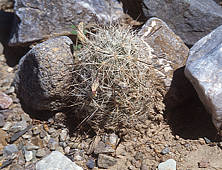 |
Mammillaria tetrancistra Engelmann 1852 (California Fishhook Cactus)
This small cactus has a globular to cylindrical stem up to 6 in tall, largely obscured by the spines. The areoles have 3-4 dark-brown hooked central spines and 20 - 60 white radial spines. Flowers are in shades of pink and are followed by shiny red fruit full of black seeds.
Native to the Mojave and Sonoran Deserts of the South-Western USA into Mexico, including Southern Arizona, South-East California, Southern Nevada and South-East Utah.
Photo: Death Valley National Park.
|
 |
Mammillaria varieaculeata Buchenau 1966
This cactus clumps up by dichotomous division of heads and also by basal offseting. Spine length is variable within the widl population. Axils produce 10 - 25 white bristles, 17 - 24 yellowish-brown radial spines and 1 - 5 darler brown central spines.
The small flowers are red and are followed by scarlet club-shaped fruit.
Native to the southern part of the Mexican state of Puebla near its border with Oaxaca.
|
 |
Mammillaria wiesingeri ssp. apamensis (W. Reppenhagen) D.R. Hunt 1997
These small globose cacti are solitary or clumping with age. Tubercles produce 13 - 16 yellowish radial spines and 1 - 2 darker central spines. Flowers are pink.
Native to the Mexican state of Hidalgo.
|
 Matucana Britton & Rose 1922 Matucana Britton & Rose 1922
Named for: The town of Matucana in central Peru, capital of the province Huarochirí.
The genus Matucana includes around 20 species of small globular or short cylindrical cacti with bright green stems and shallow tuberculate ribs. The showy funnel-shaped flowers with long floral tubes are often red but also pink, orange, yellow or white.
Native to the Andean highlands of central Peru above 8000 ft above sea level. These plants are sensitive to moisture and although some species tolerate light frost it is best to keep them at temperatures above 10°C during the Winter.
The genus Eomatucana Ritter has been merged into Matucana.
|
 |
Matucana aureiflora F. Ritter 1965
Syn. Borzicactus aureiflorus (Ritter) Donald 1971
Name: aureiflora = golden flowers
This flattened globular cactus has a glossy green stem with pectinate spines supported by a tap root. The spination varies from a robust cage-like structure to very minimal spination allowing the sculptural form of the plant body to be appreciated. The areole of young plants produces a vestigial leaf scale. The golden-yellow flowers remain open day and night.
Native to Peru, growing in the valleys of the Andes around 9500 ft above sea level.
|
 |
Matucana intertexta F. Ritter 1963
Name: Latin intertextus = interwoven, referring to the spines
This small globular cactus has a dark green body patterened by rounded tubercles with curved black radial spines and 1 - 4 central spines. Plants are usually solitary but may produce occasional basal offsets.
Native to the Cajamarca region of Peru.
|
 |
Matucana madisoniorum (Hutchison) G. D. Rowley 1971
Syn. Submatucana madisoniorum (Hutchison) Backeberg 1966, Borzicactus madisoniorum Hutchison 1963.
Named for: Mr. & Mrs. Madison who funded the expedition that found the plant.
This flattened globular to elongated cactus is usually solitary but may offset with age. The stem has a matt blue-green surface with prominent rounded ribs bearing slightly wooly areoles that tend to lose most of their spines as the plant matures. Juvenile plants have a dense array of curving spines. Flowers are bright orange-red with a long floral tube, produced throughout the Summer. A form 'alba' with a white flower is known.
Native to Amazonas region of Peru, growing at low altitudes near the edge of the Amazon rain-forest.
|
 |
Matucana weberbaueri (Vaupel) Backeberg 1939
Syn. Cleistocactus sepium (Kunth) A.Weber 1904
Named for: August Weberbauer, Prussian (German) biologist
A usually-solitary globular cactus whose areoles produce 25 - 30 long stright yellow-brown spines. Flowers are yellow to orange. In cultivation may offset with maturity.
Native to the Peruvian region of Amazonas, around 6800 ft above sea level.
|
 Melocactus Link & Otto (Turk's cap cactus) Melocactus Link & Otto (Turk's cap cactus)
Name: Latin Melus = melon + cactus
The genus Melocactus includes about 40 species of cacti from the Caribbean, Mexico and South America. Juvenile plants have globose green bodies with 8 - 27 prominent ribs and stout spines. As these plants mature the main stem ceases growth and they develop a cephalium consisting of a dense mass of areoles with short spines at the apex of the plant. This structure may keep growing for years, in some species exceeding the size of the main body. The cephalium is often orange but may be white and produces many small, often pink flowers. Flowers are followed by waxy pink or red fruits like miniature candles.
Native to a range including the Caribbean Islands, Western Mexico, central America, Brazil to Southern Peru. In cultivation a Melocactus requires constant warmth to prevent marking or collapse.
|
 |
Melocactus bahiensis (Britton & Rose) Luetzelburg 1923
Name: refers to presence in state of Bahia, Brazil
Flowers are pink to magenta, followed by reddish fruit.
Native to Brazil.
Photographed at RBG Kew.
|
 |
Melocactus ernestii Vaupel 1920
Named for: Ernst H.G. Ule (1854 - 1915) German botanist and explorer of Brazil
This large Melocactus has the longest spines in the genus. Flowers are pink to red.
Native to Brazil.
Photographed at RBG Kew.
|
 |
Melocactus peruvianus Vaupel 1913
Name: refers to presence in Peru
Native to Ecuador and Peru.
Photographed at RBG Kew.
|
 |
 |
Melocactus zehntneri (Britton & Rose) Luetzelburg 1923
Named for: Leo Zehntner (1864 - 1961) Swiss entomologist & botanist
Native to North-Eastern Brazil.
Photographed at RBG Kew.
|
 Myrtillocactus (von Martius) Console 1897 Myrtillocactus (von Martius) Console 1897
Name: the fruits resemble those of Bilberry (Vaccinium myrtillus)
The genus Myrtillocactus includes 4 species of shrubby, tree-like (25 ft) cacti with few (4-8) ribs and frequently-branching glaucous-green stems. Areoles may be without spines or have a single long, thick central spine with a few short, stout radial spines. Each areole can produce several greenish-white, waxy flowers less than 1 in long, and with short floral tubes. Flowers are followed by edible berries.
Native to Mexico including Baja California to Guatemala.
|
 |
Myrtillocactus cochal (Orcutt) Britton & Rose 1909 (Candelabra Cactus)
Name: 'cochal' is the common name for this plant
Myrtillocactus cochal grows as dense shrubs up to 12 ft tall with a short woody trunk bearing many six to eight-ribbed branches. Areoles have a long central spine with five shorter radial spines. The small flowers are greenish-white and followed by edible maroon berries.
Native to Baja California. Photographed at RBG Kew.
|
 |
Myrtillocactus geometrizans (von Martius) Console 1897 (Bilberry Cactus, fruit = Garambullo)
Name: Latin geometricus = geometric, referring to the architectural stems
The robust nature of Myrtillocactus geometrizans makes it suitable for grafting stock, although it is not cold-hardy.
Each areole can produce several brownish buds that open into greenish-white, waxy flowers less than 1 in long, and with short floral tubes. Flowers are followed by edible, blue berries which are harvested for sale in Mexican markets.
Native to Mexico including Baja California to Guatemala and widely cultivated. A cristate form is commonly seen in cultivation.
Photographed at RBG Kew.
|
Neolloydia Britton & Rose 1923
Named for: Professor Francis Ernest Lloyd (1868 - 1947) British botanist who worked in America.
This genus currently includes 2 species of cacti native to the dry Chihuahua Desert of Southern Texas and Northern Mexico. Several species have been transferred to Echinomastus.
|
 |
Neolloydia conoidea Britton & Rose 1922 (cone catus, Chihuahuan beehive)
Name: Greek konos = cone + oideos = a form or type of
The unbranched ovate to conical body can reach 9in tall and 3in diameter. Tubercles are grooved. Flowers are pink to magenta with a white outer surface and a scaly floral tube.
Widely distributed in Western Texas and the Mexican states of Coahuila, Durango, Nuevo León, San Luis Potosí, Tamaulipas, and Zacatecas, typically growing on limestone and often locally abundant.
|
Neolloydia intertexta (Engelmann) L.D. Benson 1969 -
See Echinomastus intertextus
|
 Oreocereus
(A.Berger) Riccob. Oreocereus
(A.Berger) Riccob.
Name: Greek oros = mountain + Latin cereus = candle
This genus includes 9 species of short columnar cacti with ribbed bodies that are covered in white hairs that are degenerate radial spines. Sharp central spines extend beyound the hairs. The tubular flowers are usually pink to red or orange.
Native to elevations of at least 10,000 ft in the Andes of Argentina, Bolivia, Chile, and Peru. The wooly covering doubtless protects against the harsh light and cold nights, but is probably also important for harvesting moisture from fogs by condensation on the hairs.
|
 |
 |
Oreocereus celsianus (Salm-Dyck) A.Berger ex Riccobono (Old Man of the Mountains)
Named for: Jacques Philippe Martin Cels (1740 - 1806) French botanist
This columnar (10 ft) cactus has a body with 10 - 25 ribs, covered in white hairs through whic protrude sharp brown spines. Mature plants clump up by basal offsetting. The tubular red flowers are attractive to humming birds.
Native to Andes mountains of Argentina, Bolivia and Peru.
|
 
Oreocereus doelzianus (Backeberg) Borg 1937 ()
Syn. Morawetzia doelziana Backeberg 1936, Borzicactus doelzianus (Backeberg) Kimnach 1960
Named for: Bruno Dölz (1906 - 1945) German cactophile and president of Deutsche Kakteen Gesellschaft.
The 3in diameter stems have 10 - 11 ribs and grow up to 3ft tall. Brownish spines are hidden amonmg many hairs that protect against cold and condense moisture from fogs. As stems mature they develop an apical pseudocephalium of wool and long bristles, which was used to justify separation into the genus Morawetzia. The tubular scarlet flowers with a hairy flower tube appear at the apex of the stems, opening at their tips to display a ruff of pointed petals and yellow stamens.
Native to high valleys among the Andes mountains of Peru, growing at elevations of 8000 - 9800 ft above sea level on Eastern slopes where they will get the morning sun. At such altitudes they experience freezing conditions and are cold hardy under very dry conditions, but otherwise very sensitive to moisture.
|
 |
Oreocereus trollii Kupper 1929 (Old Man of the Mountain / Andes)
Syn. Borzicactus celsianus var. trollii (Kupper) G.D.Rowley 1986
Named for: Carl Troll (1899 - 1975) German botanist & geographer
This short (2 ft) columnar cactus has a ribbed body that is densely coated in matted white hairs with protruding brown spines. Mature plants clump up by basal offsetting. The tubular flowers are violet-red to pink.
Native to Andes mountains of Northern Argentina and Southern Bolivia growing at elevations of up to 14,000 ft above sea level. Popular in cultivation but needs careful watering to avoid the white hairs wicking up salts and becoming dicoloured. Avoid watering during cold weather and Winter.
|
 Pachycereus (A. Berger) Britton & Rose 1909 Pachycereus (A. Berger) Britton & Rose 1909
Name: Greek pakhus = thick + Latin cereus = candle
The are 9 - 12 species of Pachycereus, whose stout ribbed stems form columnar shrubs and very large tree-like cacti branching well above the ground to form a candelabra. Young growth is often fiercely spined, but mature growth above the reach of herbivores much less spiny. The large tubular flowers have a hairy or scaly brownish outer surface and white to pale pink interiors.
Native to Mexico, Baja California and the Southern edge of Arizona. Slow growing Pachycereus pringlei (Cardón) is fairly common in cultivation as an immature plant. Some species contain toxic, psychoactive alkaloids and may have been used in native ceremonies.
|
 |
Pachycereus pringlei (S. Watson) Britton & Rose 1909 (Cardón, Mexican Giant Cardón)
Named for: Cyrus Guernsey Pringle (1838 - 1911) American botanist, explorer & plant breeder.
Common name: Cardón from the Spanish cardo = thistle
This is one of the largest cacti in the world, whose trunk with 11 - 17 ribs typically grows over 30ft tall and 3 - 4ft in diameter. Specimens have been recorded as growing 63ft tall during a lifespan of hundreds of years. Small specimens, typically seen in glass-house collections, are very spiny with 20 - 30 gray spines per areole but the spines are mostly lost as the trunk grows above the reach of herbivores. Mature specimens have side branches to the trunk forming a candelabra of branches. White flowers are produced in the Spring followd by tan coloured, spiny fruits.
Native to the Mexican states of Sonora and Baja California. Symbiotic nitrogen-fixing micro-organisms on the roots allow this cactus to grow without soil, even on bare rock. The spiny fruits contain edible pulp. This cactus produces alkaloids and a slice was traditionally used to treat rheumatism and aches.
|
Lophocereus (A. Berger) Britton & Rose 1909
Plants in this genus have been transferred to Pachycereus.
|
 |
Pachycereus schottii D.R. Hunt 1987 (Senita Cactus)
Syn. Lophocereus schottii Britton & Rose 1909
Mature flowering stems develop a pseudocephalium of long, hairlike, grey spines towards their ends.
Photograph: Organ Pipe Monument Az.
|
 Parodia Spegazzini 1923 Parodia Spegazzini 1923
Named for: Lorenzo Raimundo Parodi, Argentine biologist
The genus Parodia includes about 50 species of globular cacti, some of which elongate into short columnar plants. All species have deep ribs furnished with spines along their edge and usually single yellow or red flowers near the growing point, produced throughout the year.
Parodia are native to Argentina, Brazil, Colombia, Paraguay, Peru and Uruguay. The genus was expanded by transfer of species from the genera Eriocactus, Notocactus and Wigginsia. These free-flowering cacti are popular and easy to grow in a sunny place.
Notocactus (K.M. Schumann) Frič 1928
Name: Greek = cactus of the south
The 25 species from the obsolete genus Notocactus were moved into the genus Parodia in the 1980s but the name persists in books and plant labels. Notocacti have globose bodies elongating into short columns. The relatively large, funnel shaped flowers in yellows and red are produced throughout the year, each flower usually lasting several days.
Notocacti are native to lowlands of Argentina, Paraguay, Uruguay, and Southern Brazil.
|
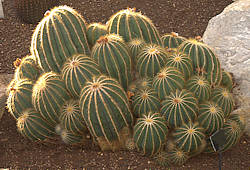 |
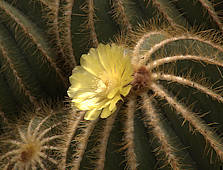 |
Parodia magnifica (Ritter) F. H. Brandt 1982
The spherical to columnar blue-green plant body has dense yellow to brown spines and hairs along its ribs. Old plants clump up by offsetting. Pale yellow flowers are produced at the apex of the cactus.
Native to Southern Brazil, Paraguay, Uruguay and Argentina.
Photo: a very old clump at RBG Kew.
|
 |
Parodia scopa (Sprengel) N. P. Taylor 1987
Syn. Notocactus scopa (Sprengel) A. Berger 1929
Name: Latin scopa = broom, referring to the dense spines
A globular cactus becoming cylindrical with age. The spiny, wooly crown produces yellow flowers in early Summer.
Native to Southern Brazil and Uruguay.
|
 |
Notocactus succineus F. Ritter 1970 (Silver Ball Cactus)
Syn. Parodia scopa subsp. succinea (F. Ritter) Hofacker & P.J. Braun 1998
|
 |
Parodia warasii (F. Ritter) F.H. Brandt 1982
Named for: Eddie Waras, Bromeliad & Orchid collector, nurseryman from Sao Paulo, Brazil
This globular to short columnar cactus is similar to P. magnifica but with a bright green stem offsetting the golden spines along the ribs. Stems may offset or remain solitary. Golden yellow flowers are produced around the crown of the plant in the Summer.
Native to the Brazilian state of Rio Grande do Sul .
Photograph: bedded out for the Summer at RBG Kew.
|
 Peniocereus (A. Berger) Britton & Rose 1909 (Night-Blooming Cereus, Queen of the Night) Peniocereus (A. Berger) Britton & Rose 1909 (Night-Blooming Cereus, Queen of the Night)
Name: Latin penis = tail + Latin cereus = candle
The genus Peniocereus includes about 8 species of cacti from the South-Western USA and Mexico. A very large underground tuber supports long thin stems that scramble through other supporting bushes. Flowers typically open during the night.
|
 |
 Wilcoxia Britton & Rose 1909 Wilcoxia Britton & Rose 1909
Named for: Timothy E. Wilcox, US General
Some species of Wilcoxia have been transferred to Peniocereus and the genus Wilcoxia
has been reduced to Echinocereus section Wilcoxia (Britton & Rose) N.P. Taylor.
|
Wilcoxia viperina
Syn. Peniocereus viperinus
|
 Rebutia K. Schumann 1895 Rebutia K. Schumann 1895
Named for: Pierre Rebut (1827 - 1898) French vine grower, cactus collector & nursery owner.
The genus Rebutia consists of small globular free-flowering cacti native to Boliva and Argentina. The bodies do not have ribs but regularly-arranged tubercles. Most species form clumps by offsetting from their base. The red, orange, yellow and white flowers are relatively large compared to the plant body and appear to be self-fertile, producing seed which may germinate around the plant.
Because of repeated splitting and lumping of genera, and transfer of some species into Lobivia / Echinopsis the number of species of Rebutia is indeterminate, but probably in the range 12 - 40 species. Species that were formerly in the genera Aylostera, Sulcorebutia, Weingartia and others have been lumped into Rebutia, so these often variable plants are seen with many synonyms.
These popular cacti are easy to grow and flower freely on a sunny window-ledge. Several hybrids are in circulation.
|
 |
Rebutia albiflora Ritter & Buining 1963
Named for: Latin albi = white + flora = flower
This clumping cactus has small globose stems covered with soft radial spines. The relatively large (1 in diameter) flowers are white to pinkish-white with an externally pink flower tube and are followed by dry red fruits.
Native to South-East Bolivia.
|
 |
Rebutia caineana Cárdenas 1966
Syn. Rebutia breviflora (Backeberg) D.R. Hunt 2002 Syn. Sulcorebutia breviflora Backeberg 1966
This globular cactus has a long, thick tuberous root and clumps up by basal offsetting. Yellow funnel-shaped flowers are produced freely on mature stems.
Native to Cochabamba, Potosi, Bolivia, where it grows among sandstone rocks at an altitude of 6500 - 9800 ft above sea level. The tap root requires careful watering or it may rot.
|
 |
Rebutia heliosa Rausch 1970
Name: Greek heliosa = of the sun
This miniature cactus has tiny heads of up to an inch in diameter, clumping up to form a low mound. The stems are covered in short silvery pectinate spines in a spiral formation. There is a fleshy taproot under the cactus.
Native to high mountains of Bolivia, growing at 8000 - 9800 ft above sea level.
|
 |
Rebutia heliosa x albiflora
An attractive, free-flowering hybrid that quickly forms a mat of small, globular plant bodies. As with many hybrids, some variation is seen in the flower colours and selected forms have been propagated with flower colours from pale pink to peach.
|
| |
Rebutia neocummingii (Backeberg) D.R. Hunt 1987 see:
Weingartia neocummingii
|
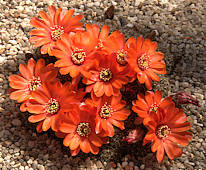 |
Rebutia pygmaea (R.E. Fries) Britton & Rose 1922
Syn. Lobivia pygmaea (R.E. Fries) Backeberg 1935
This small clumping cactus has around 60 synonyms, reflecting variability over its large range.
Native to Bolivia and Argentina.
|
 |
Rebutia spegazziniana Backeberg 1933
Syn. Rebutia tarijensis Ritter 1977
|
 |
Rebutia steinbachii Werderman 1931
Syn. Sulcorebutia steinbachii (Werderman) Backeberg 1951
|
 Rhipsalis Gärtner 1788 (Mistletoe Cacti) Rhipsalis Gärtner 1788 (Mistletoe Cacti)
Name: Greek rhips = wickerwork, refering to slender, flexible stems.
Rhipsalis is the largest genus of epiphytic cacti. The succulent photosynthetic stems may be cylindrical, angular of flattened and vary considerably in thickness. They usually branch frequently.
R. pilocarpa is unique in having stems that are densely covered in areoles with bristles. In all other species, spines are absent or only on juvenile growth. Flowers are usually small and white, occasionally yellow and red in one species (R. hoelleri.)The fruits are white, pink, red or yellow berries.
With the exception of Rhipsalis baccifera all species are native solely to tropical rainforests of South America, especially Brazil, and to the Caribbean.
|
Rhipsalis baccifera (J.S. Mueller) Stearn 1939 (Mistletoe Cactus)
This is a variable species with a wider natural distribution than any other cactus. South American plants are diploid but those from Mesoamerica, the Caribbean and elsewhere are tetraploid. R. baccifera is found also in tropical rainforests of Africa, Madagascar, Seychelles, Mauritius, Reunion, India and Ceylon. As R. baccifera is not ancestral to Cactaceae and unlikely to have evolved before separation of the continents, this pandemic distribution may reflect transport by migratory birds or humans, perhaps for the sweet berries.
|
 |
Rhipsalis baccifera ssp. mauritiana (De Candolle) Barthlott 1987 (Mistletoe Cactus)
This sub-species from the Indian Ocean area is tetraploid with 44 chromosomes. The white berries are edible and larger than those of the diploid sub-species.
|
 |
 |
Rhipsalis mesembryanthemoides Haworth 1821 (Clumpy Mistletoe Cactus )
Name: mesembryanthemoides = appearance similar to genus Mesembranthemum
The branching stems of this epiphyte produce many half-inch long side-shoots packed together along the main stem. Areoles have fine white hairs and some aerial roots. White flowers are followed by oblong white fruit.
Native to Brazil and not uncommon in cultivation.
|
 |
Rhipsalis neves-armondii K.Schumann 1890
Named for: Amaro Ferreira das Neves Armond, Director of the Brazilian National Museum (1892 - 1893).
This epiphyte has narrow angular to rounded, frequently-branching stems forming a clump. The stems have a few areoles along their length, but no spines. Some wool is produced at the base of flowers and fruit. Flowers are white with a yellow or pink center followed by small red berries.
Native to Brazil, typically hanging in clusters from trees. As with most under-storey epiphytes, partial shade is better than full sun. Occasional aerial roots are produced from areoles and the plant may be grown as an epiphyte as illustrated, if sprayed regularly.
|
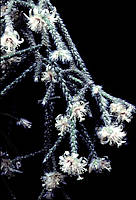 |
 |
Rhipsalis pilocarpa Lofgren 1903
Name: Latin pilus = hairy + carpus = fruit
The long thin branching stems are distinctively covered in fine hairs growing from otherwise spineless areoles. In mid-Winter, bell-like white flowers are produced at the ends of the stems. The interiors of the flower tunes may be tinged with pink. Flowers are followed by red berries whose surface has areoles bearing tufts of hairs.
Native to Brazil. This is an ideal plant for a shady corner of the greenhouse or conservatory.
|
 Schlumbergera Lemaire 1858 (Christmas Cactus) Schlumbergera Lemaire 1858 (Christmas Cactus)
Named for: Frédéric Schlumberger (1823 - 1893) French cactus grower from Anthieux
The genus Schlumbergera includes 6 species of epiphytic cacti from South-Eastern Brazil. The stems are formed from flattened, jointed segments that resemble fleshy leaves. Pink flowers arise from areoles at the stem joints and notched tips of the stems and are bird pollinated. Tiny vestigial spines can also be found in these places.
By selection and hybridization, plant breeders have produced many varieties with different forms and flower colours. Flowering is controlled by temperature and short day length.
Zygocactus Schumann 1890
The obsolete genus Zygocactus is included in Schlumbergera.
|
|
Schlumbergera truncata (Haworth) Moran 1953
Syn. Zygocactus truncatus (Haworth) K. Schumann 1890 (Christmas cactus)
The traditional "Christmas Cactus" is a hybrid Schlumbergera x buckleyi with a magenta flower. The wild form of Schlumbergera truncata in Brazil has a red flower.
A range of hybrids with flowers in other colours have become available recently. However, many are temperature-sensitive and revert to pink unless the buds develop in warm conditions, although bud initiation occurs best in cool temperatures.
Notes on growing & flowering Christmas cacti
|
 Sclerocactus Britton & Rose 1922 Sclerocactus Britton & Rose 1922
Name: Greek sclero = hard referring to fruit + cactus
The genus Sclerocactus includes about 15 species of particularly xerophytic cacti from North America. Plant bodies are globular to short columns with tuberculate ribs and dense spination. Most species have at least one hooked spine at each areole but a few species do not have hooks. Funnel-shaped flowers in shades of pink, yellow, and greenish are produced near to the growing point.
Native to the Southern USA and Northern Mexico.
The genera Ancistrocactus, Echinomastus, Glandulicactus and Toumeya are lumped into Sclerocactus by some authors.
Toumeya Britton & Rose 1922
Named for: James W. Toumey (1865 - 1932) Dean of School of Forestry, Yale University (1919 - 1922)
The monotypic genus Toumeya was merged into Sclerocactus Britton & Rose 1922.
|
 |
Sclerocactus papyracanthus (Engelmann) N.P. Taylor 1987 (Paper-Spined Cactus)
Syn. Toumeya papyracantha Britton & Rose 1922
Photograph: gypsum salt flats in front of Guadalupe Mountains, Texas.
|
 |
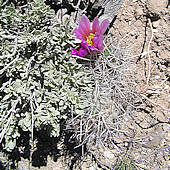 |
Sclerocactus parviflorus Clover & Jotter 1941 (Devil's Claw Cactus)
Name: Latin parviflorus = small flowers, perhaps not entirely appropriate
Extreme left: Robin Howard, Cheyenne Mountain State Park, Colorado. June 2008
Left: Robin Howard, Colorado Springs, Colorado. June 2008
|
 |
Sclerocactus polyancistrus (Engelmann & Bigelow) Britton & Rose 1922
Syn. Pediocactus polyancistrus (Engelmann & J.M. Bigelow) Arp 1972
This species, clumping with age, has a cylindrical stem up to 10 in tall, obscured by dense spination. Areoles have reddish or whiteish long central spines with hooked tips and several white radial spines. The perfumed flowers are pink and followed by scaly fleshy fruit.
Native to the Mojave Desert of Eastern California and Southern Nevada, often on limestone soils.
Photo: Death Valley National Park.
|
 |
Sclerocactus scheeri (Salm-Dyck) N.P. Taylor 1987
Syn. Ancistrocactus scheeri (Rose) Britton & Rose 1923
Named for: Friedrich Scheer (1792 - 1868) German botanist and cactus enthusiast.
A fleshy tuberous taproot supports a usually-solitary, large globular cactus. Areoles have 13 - 28 radial spines and 3 -4 hooked central spines. Juvenile plants have only radial spines. Flowers are bright green to yellowish in early Spring.
Native to Texas and the Mexican states of Nuevo León and Tamaulipas. Indians used the central spines as fish hooks.
Photo: Amistad Recreation Area, Texas.
|
 |
 |
Sclerocactus uncinatus (Galeotti) N.P. Taylor 1987 (Turk's Head Cactus)
Syn. Glandulicactus uncinatus (Galeotti) Backeberg 1939
Photo: Black Gap Wildlife Management Area near Dog Canyon, Texas.
|
 Selenicereus (A. Berger) Britton & Rose 1909 (Moonlight Cacti) Selenicereus (A. Berger) Britton & Rose 1909 (Moonlight Cacti)
Named for: Selene, Greek moon goddess + Latin cereus = candle, referring to nocturnal flowering
The genus Selenicereus includes 28 species of climbing or scrambling epiphytic cacti with flat to angled stems producing aerial roots and often rooting where they touch a suitable substrate. Stems may be spiny or without spines. The funnel-shaped flowers are usually large, white, yellow to pink and very fragrant, tending to be nocturnal. Fruits are fleshy and covered with spines.

Native to rain forests of the Caribbean and central to South America.
Hylocereus megalanthus Syn. Selenicereus megalanthus (Yellow Pitahaya) widely cultivated commercially for its fruits, may be a hybrid between Hylocereus and Selenicereus.
|
 |
Selenicereus anthonyanus (Alexander) D.R. Hunt 1989 (Fish Bone Cactus)
Syn. Cryptocereus anthonyanus Alexander 1950
Named for: Dr. Harold E. Anthony (1890 - 1970) American zoologist & paleontologist, first to flower this plant
The notched stem may be an adaptation to the low light levels under the rainforest canopy, by increasing the area of the photosynthetic stem instead of producing leaves. The large fragrant flowers open for just one night.
Native to the rainforests of Chiapas, Oaxaca, Tabasco and Veracruz, Mexico.
|
 |
Selenicereus grandiflorus (Linnaeus) Britton & Rose 1909 (Queen of the Night)
Name: grandiflorus = large flowered
The large fragrant white flowers open for less than one night.
Native to Cuba, Cayman Islands, Jamaica, Haiti, Puerto Rico, Mexico, Belize, Guatemala, Honduras and Nicaragua.
|
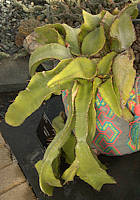 |
Selenicereus testudo (Karwinsky ex Zuccarini) Buxbaum 1965 (Dog's Tail Cactus, Pitaya De Tortuga)
Syn. Deamia testudo Britton & Rose 1920
Name: testudo = large flowered
This epiphytic cactus has long narrow angular stems that, as they mature become broad with 3 to 5 ribs furnished with sharp brown spines along their edges.
The large fragrant white flowers may be open for several days and are followed by purple spiny fruit.
Native to dry rain forests of Belize, Costa Rica, Guatemala, Honduras, Mexico, and Nicaragua where it typically scrambles along tree branches or over rocks. In cultivation, it likes full sun.
|
 Stenocactus (Schumann) Berger 1929 Syn. Echinofossulocactus Britton & Rose 1922 Stenocactus (Schumann) Berger 1929 Syn. Echinofossulocactus Britton & Rose 1922
Name: Greek steno = tight or narrow, referring to the ribs.
This genus includes 11 species of mostly solitary, small globular cacti up to 4 in in diameter, with strong fin-like ribs and prominent spination. Small funnel-shaped flowers are produced near to the growing point of the plant and are often pale with a darker longitudinal stripe.
Native to the Chihuahuan desert of Mexico. Most Stenocactus grow easily and are free-flowering.
Echinofossulocactus is a synonym of Stenocactus.
|
 |
Stenocactus crispatus (de Candolle) A. Berger ex A. W. Hill 1933
Name: Latin crispus = with wavy margins, referring to the ribs.
Widely distributed in the Mexican states of Guanajuato, Hidalgo, México Distrito Federal, México State, Oaxaca, Puebla, Querétaro, San Luis Potosí, Tamaulipas, Tlaxcala and Veracruz.
Photo: Holly Gate Cactus Nursery reference collection
|
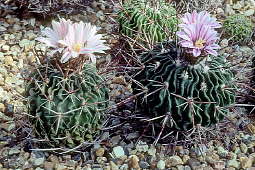 |
Stenocactus multicostatus (Hildmann ex K. Schumann) A. Berger 1929
Syn. Echinofossulocactus multicostatus (Hildmann ex K. Schumann) Britton et Rose 1922
Native to the Mexican states of Aguascalientes, Coahuila, Durango, Guanajuato, Jalisco, Nuevo León, Querétaro, San Luis Potosí, Tamaulipas and Zacatecas.
Photo: Holly Gate Cactus Nursery reference collection
|
 |
Stenocactus ochoterenianus Tiegel 1933
Name commonly seen as S. ochoterenaus.
This solitary cactus has a dark green body with up to 30 undulating ribs and yellowish wool around the apex. Flowers are white to purple with a darker central stripe.
Native to the Mexican states of Hidalgo, Queretaro and Guanajuato.
|
 |
Stenocactus vaupelianus (Werdermann) F. M. Knuth 1935
Syn. Echinofossulocactus vaupelianus (Werdermann) H. C. Whitmore 1934
Named for: Friedrich Vaupel (1876 - 1927) German botanist
This solitary species has a dark green body with around 35 undulate ribs. The body may be obscured by the strong spination, 10 - 25 radial and 1 - 4 central spines and white wool around the areoles. Flowers are pale yellow to pink, often with a darker mid-stripe.
Native to Mexian state of Hildago.
|
 Stenocereus (A. Berger) Riccobono 1909 Stenocereus (A. Berger) Riccobono 1909
Name: Greek steno = tight or narrow, referring to the ribs + cereus = candle
The genus Stenocereus includes columnar cacti, often with multiple stems from their base or branching well above ground to form a tree-like structure. The cylindrical stems have multiple ribs, slightly indented at the areoles.
Members of the genus Stenocereus are found in Mexico including Baja California, Arizona, Colombia, Costa Rica, Guatemala, Venezuela and Caribbean Islands. A single species Stenocereus thurberi (Organ Pipe Cactus) can be seen at the South-Western edge of Arizona and has a National Monument named after it. Some species are cultivated for fruit similar to a dragon fruit. Plants that were formerly classified as Hertrichocereus and Lemaireocereus have been lumped into Stenocereus.
|
 |
Stenocereus eruca (Brandegee) Gibson & Horak 1978 (Creeping Devil)
Name: Latin eruca = caterpillar
The Creeping Devil grows prostrate along the ground. It's 2in diameter spiny, cylindrical stem turns up a little at the growing point and roots where the body touches the ground. As the front of the plant grows, the rear end decays and crumbles away, so the effect is that the whole plant slowly moves forward. The stem branches near to the growing point. Eventually side branches detach and grow separately, as the decaying end reaches their branch point. The 4in long nocturnal flowers are pale yellow to pink followed by spiny fruit.
Native to sandy soils and coastal dunes in Baja California and Magdalena Island. This cactus is said to contain similar psychoactive alkaloids to peyote cactus and featured in native Indian ceremonies.
|
 Thelocactus (K. Schumann) Britton & Rose 1922 Thelocactus (K. Schumann) Britton & Rose 1922
Name: Greek thele = wart or nipple + cactus
The genus Thelocactus includes up to 15 species of small globular cacti with ribbed bodies, usually with angular tubercles. Areoles have up to 20 fine radiating spins with up to 6 stronger central spines which are sometimes hooked. These plants often have colourful spines in white, gray, yellow and reddish-brown. Funnel-shaped, relatively large white, yellow, red or magenta flowers are produced at the apex of the plant.
Native to Texas and Northern to central Mexico. Most species are solitary but some will clump up.
The genus Hamatocactus is now included in Thelocactus.
|

Los Caballos, Brewster |

County, Texas |
Thelocactus bicolor (Galeotti ex Pfeiffer) Britton & Rose 1922
This solitary, globular cactus has 8 ribs bearing rounded tubercles. Areoles have glands and produce 8 - 18 yellowish to reddish radial spines and 3 - 4 central yellowish to reddish spines. Magenta flowers with a red throat are produced from Spring to Autumn.
Native to a wide range from Texas to the central Mexican state of San Luis Potosí, growing on limestone or sandstone soils. Numerous varieties have been named from different parts of the distribution.
Thelocactus bicolor subsp. flavidispinus (Backeberg) N.P. Taylor 1998 (Glory of Texas)
Name: flavidispinus = yellow spined
A globular to short columnar cactus with 13 ribs with tubercles,mostly obscured by dense straw-coloured to red spination. Areoles have 12 - 20 radial spines and 3 - 4 central spines. Short-lived, large magenta flowers are produced in late Spring.
Native to Big Bend Country, Texas into Mexico, growing on acidic soils. Not difficult in cultivation, but tends to grow taller than in its habitat.
|

West of Terlingua, Texas |

author's plant |
 |
Thelocactus conothelos (Regel & Klein bis) Backeberg & F.M. Knuth 1935
A globular cactus with four sub-species and a somewhat variable flower colour from white, yellow, red to purple.
Native to the Chihuahuan Desert in the Mexican states of Nuevo León, San Luis Potosí and Tamaulipas.
|
 Weingartia Werdermann 1937 Weingartia Werdermann 1937
Named for: Wilhelm Weingart (1856 - 1936), German amateur cactus expert and close friend of Werdermann
Weingartia is a genus with 60 species of globular to shortly-cylindrical cacti with 12 - 18 tuberculate ribs arranged as a spiral. Yellow to orange funnel-shaped flowers are produced near to the growing point with up to 3 flowers per areole.
Native to the Andes of Southern Bolivia and North-West Argentina at elevations of up to 12,500 ft. Some authors have lumped Weingartia into Rebutia, with three-quarters of the species as synonyms of R. canigueralii and R. neocumingii, but this is still controversial.
|
 |
Weingartia neocumingii Backeberg 1950
Syn. Rebutia neocumingii (Backeberg) D.R. Hunt 1987
Named for: Hugh Cuming (1791-1865) English naturalist, + prefix Greek néos = new
The globose to short cylindrical stem has 16 - 18 ribs of tubercles, typically spiraling around the body. Tubercles bear 2 - 8 central and 5- 24 brownish radial spines. In early Summer, bright yellow to orange flowers are produced all over the body with up to 4 flowers per areole.
Native to dry valleys of the Andes of Bolivia and Peru growing at up to 9800 ft above sea level. Needs a cold, dry Winter to flower well. A very variable species with many synonyms and several forms.
|
















































































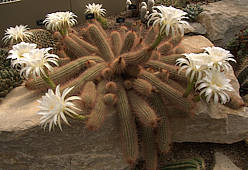
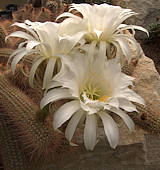

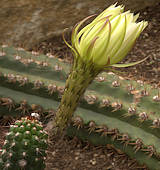















 Dec 2011
Dec 2011 Mar 2016
Mar 2016 Jul 2018
Jul 2018 Mar 2019
Mar 2019 Sept 2022
Sept 2022









































































 Peniocereus (A. Berger) Britton & Rose 1909 (Night-Blooming Cereus, Queen of the Night)
Peniocereus (A. Berger) Britton & Rose 1909 (Night-Blooming Cereus, Queen of the Night)


